Have you ever walked through a stunning garden and felt completely transported to another world? Beautiful gardens have the power to inspire us, calm our minds, and connect us with nature in the most meaningful ways. Whether you have a sprawling backyard or a tiny balcony, creating an inspiring outdoor space is within your reach. Today's garden designs embrace everything from wild natural landscapes to sleek modern spaces, drought-resistant themes to lush tropical paradises. The beauty lies in finding the style that speaks to your heart and fits your lifestyle. With sustainability and low-maintenance approaches leading garden trends, you can create spaces that are both environmentally friendly and personally rewarding. Each garden tells a unique story through carefully chosen plants, materials, and design elements that work together harmoniously.
1. Mediterranean Courtyard Gardens
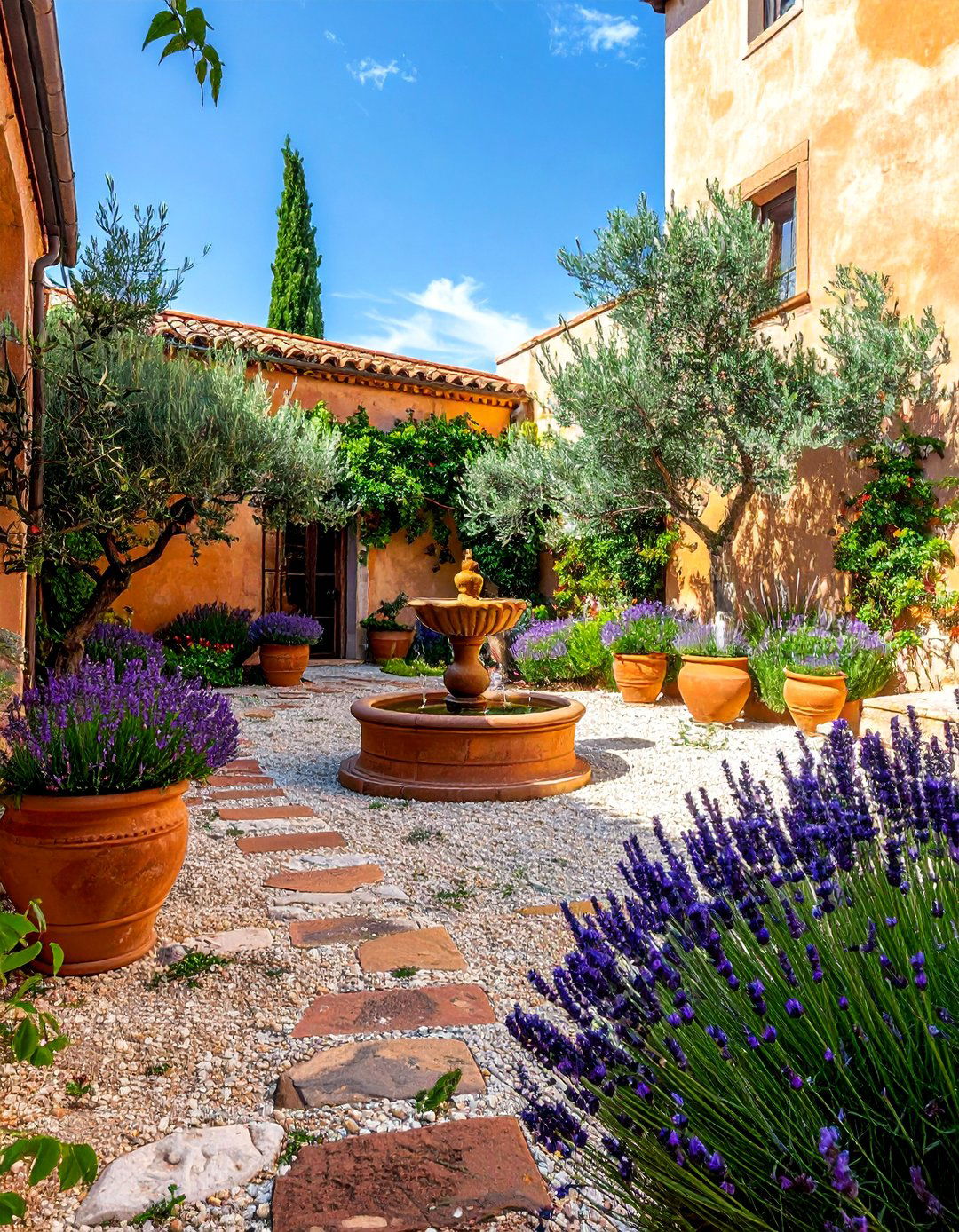
What if your backyard could transport you to the sun-drenched coastlines of Italy or Spain every single day? Mediterranean gardens capture the relaxed elegance of southern European landscapes through drought-tolerant plants, natural stone materials, and architectural features. These gardens center around courtyards with terracotta pots filled with lavender, rosemary, and olive trees. Gravel paths wind between raised planting beds containing silvery herbs and colorful wildflowers like poppies and salvia. Stone walls, wrought iron gates, and water fountains create authentic architectural elements. The color palette features warm earth tones with splashes of blue and purple from Mediterranean plants. These gardens thrive in sunny locations with minimal water requirements.
2. Japanese Zen Gardens
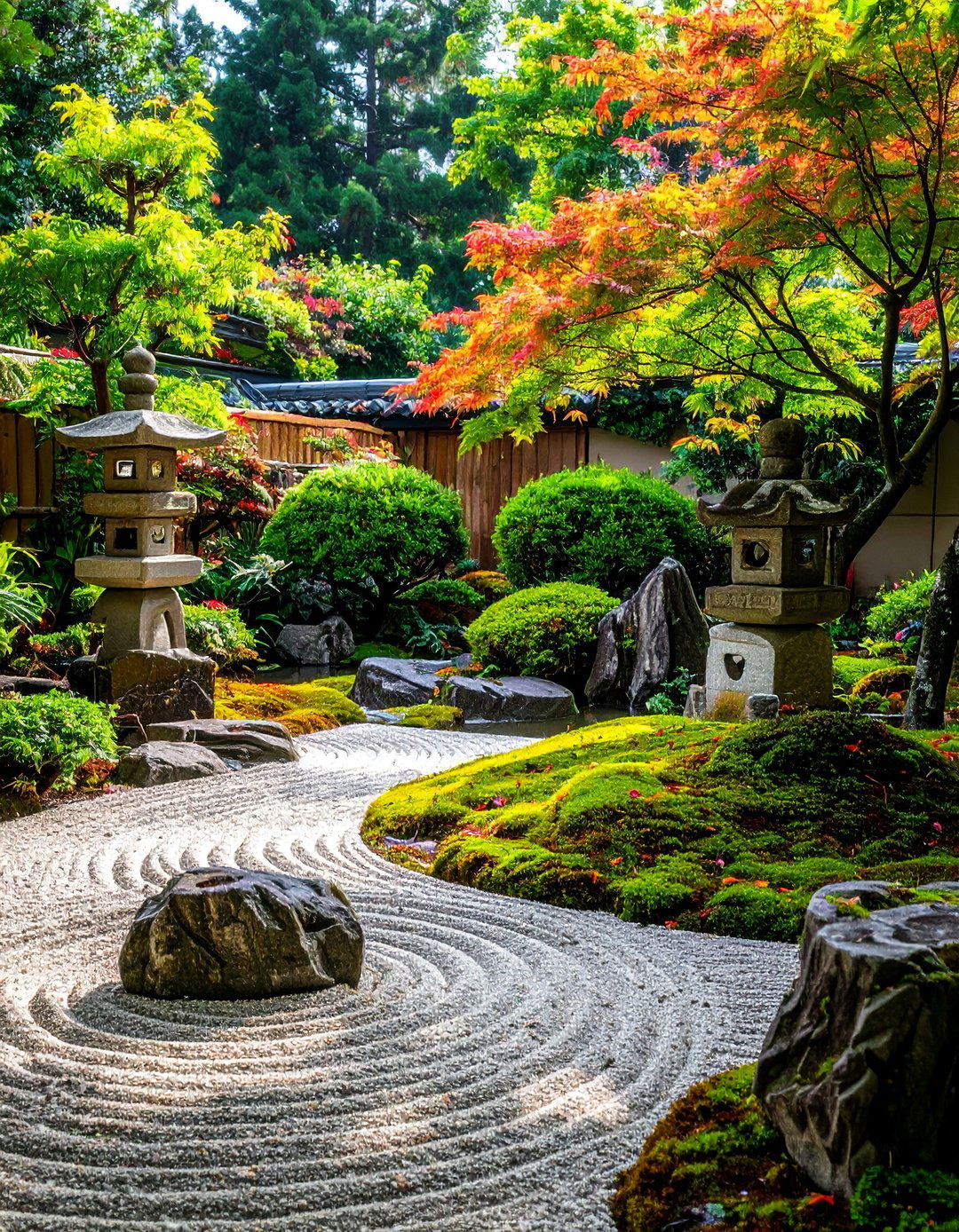
Japanese gardens create peaceful retreats through carefully balanced elements of stone, water, and plants. These contemplative spaces feature raked gravel patterns symbolizing flowing water, strategically placed rocks representing mountains, and pruned trees like Japanese maples and black pines. Bamboo fountains provide gentle water sounds while stone lanterns add traditional architectural interest. The design emphasizes harmony and seasonal beauty with plants chosen for their changing colors throughout the year. Moss creates soft ground cover in shaded areas, while stepping stones guide visitors along meandering paths. These gardens work beautifully in smaller spaces and require minimal maintenance once established. The philosophy focuses on creating balance between natural and designed elements.
3. English Cottage Gardens
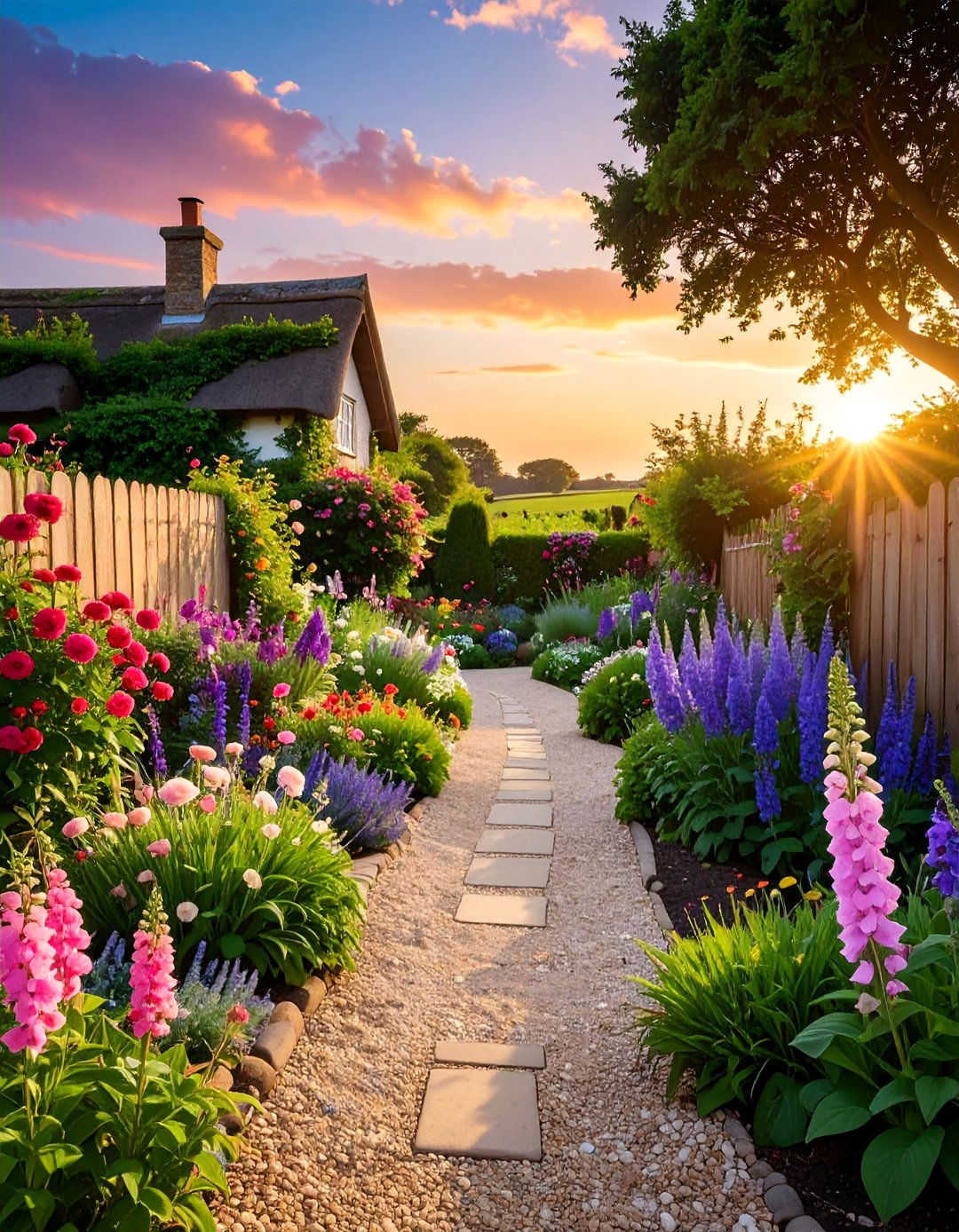
Have you ever dreamed of a garden overflowing with old-fashioned charm and romantic blooms? Cottage gardens embrace delightful chaos through mixed plantings of perennials, annuals, and climbing roses. Delphiniums tower at the back of borders while sweet peas scramble up rustic supports. Lavender, pinks, and hardy geraniums create fragrant pathways between vegetables and herbs. These gardens blur the lines between ornamental and edible plants, with fruit trees providing structure and seasonal interest. Self-seeding flowers like foxgloves and aquilegias pop up in unexpected places, adding to the informal charm. Weathered materials like old brick paths and wooden trellises enhance the lived-in feeling that makes cottage gardens so appealing.
4. Modern Minimalist Gardens
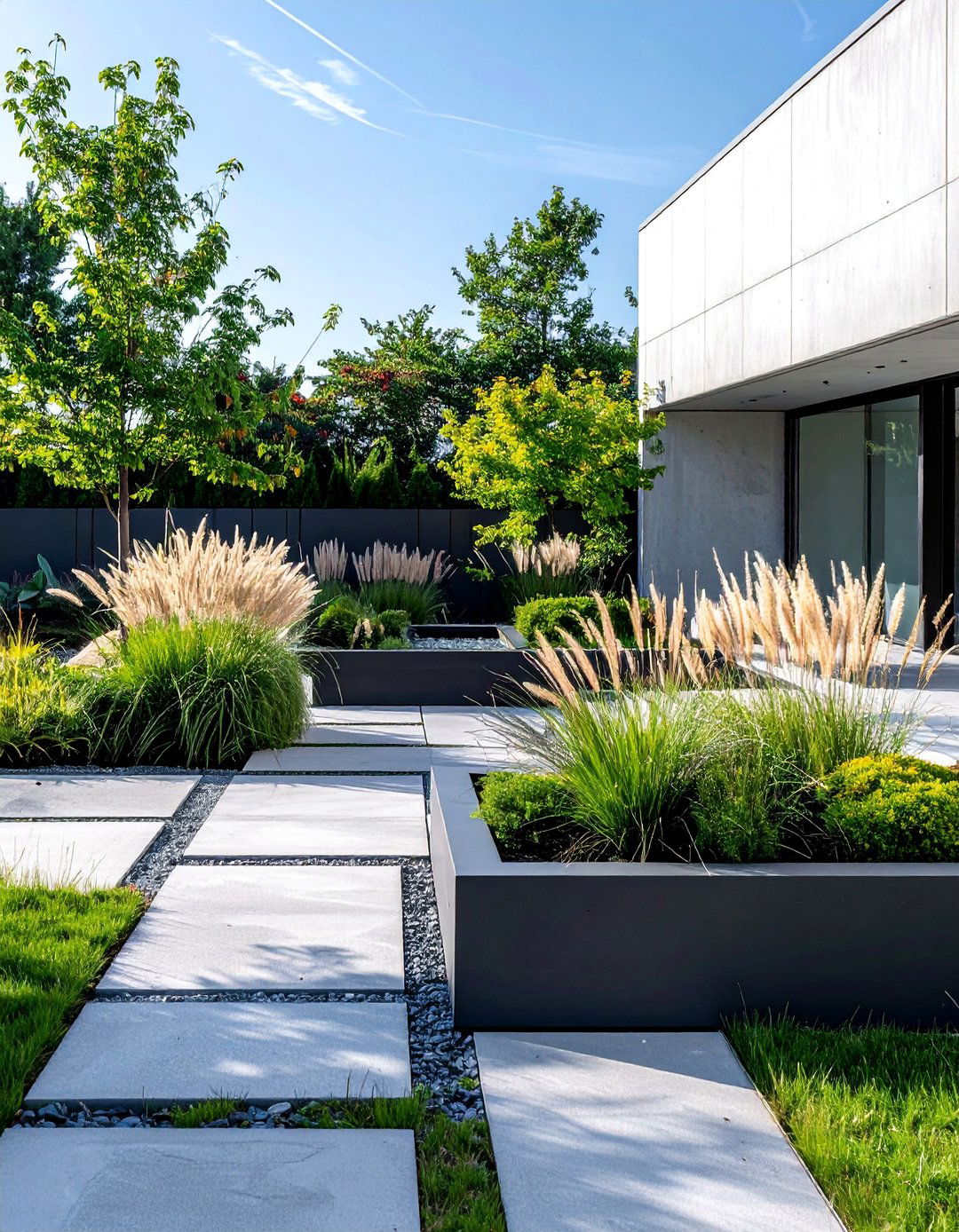
Modern gardens celebrate clean lines, architectural plants, and sophisticated simplicity. These spaces feature geometric layouts with structural plants like ornamental grasses, sculptural agaves, and clipped boxwood spheres. Hardscaping materials include concrete, steel, and natural stone in neutral colors. Water features take the form of reflecting pools or linear fountains that complement the contemporary aesthetic. The plant palette emphasizes texture and form over colorful flowers, creating year-round visual interest. These gardens work exceptionally well in urban settings where they complement modern architecture. Maintenance stays minimal through careful plant selection and efficient irrigation systems. Outdoor lighting extends the garden's beauty into evening hours with dramatic shadows and highlights.
5. Tropical Paradise Gardens
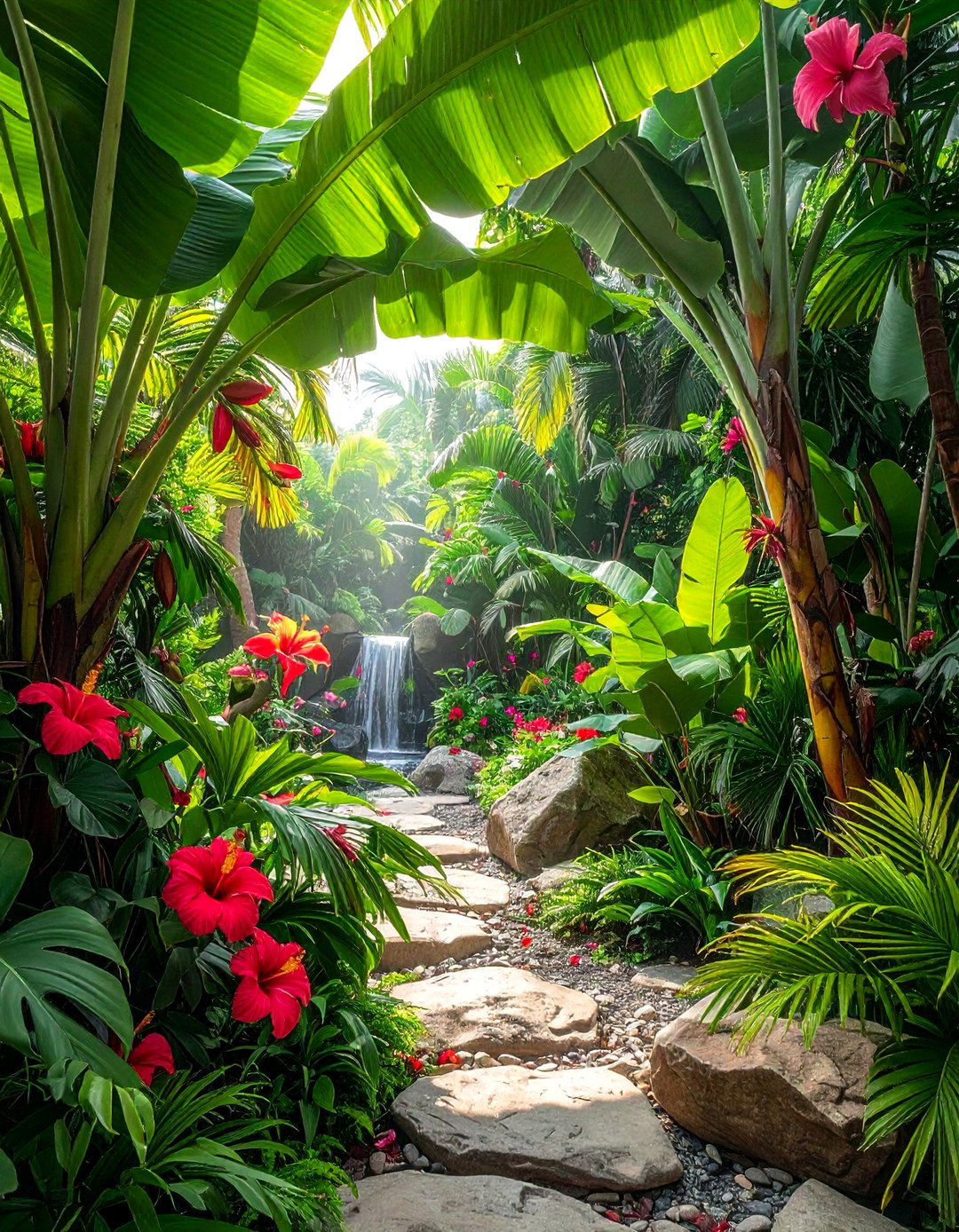
Tropical gardens transform outdoor spaces into lush, exotic retreats filled with bold foliage and vibrant colors. Large-leafed plants like elephant ears, banana trees, and tree ferns create dramatic canopies and jungle-like atmospheres. Bright flowering plants such as hibiscus, bougainvillea, and bird of paradise add stunning color throughout the growing season. These gardens thrive in warm, humid conditions but can be adapted for cooler climates using containers and seasonal planting. Water features like ponds or waterfalls enhance the tropical feeling while supporting exotic plants. Natural materials including bamboo, teak, and stone create authentic hardscaping elements. The layered planting approach mimics natural tropical ecosystems with canopy trees, understory plants, and ground covers working together harmoniously.
6. Desert Xerisca Gardens
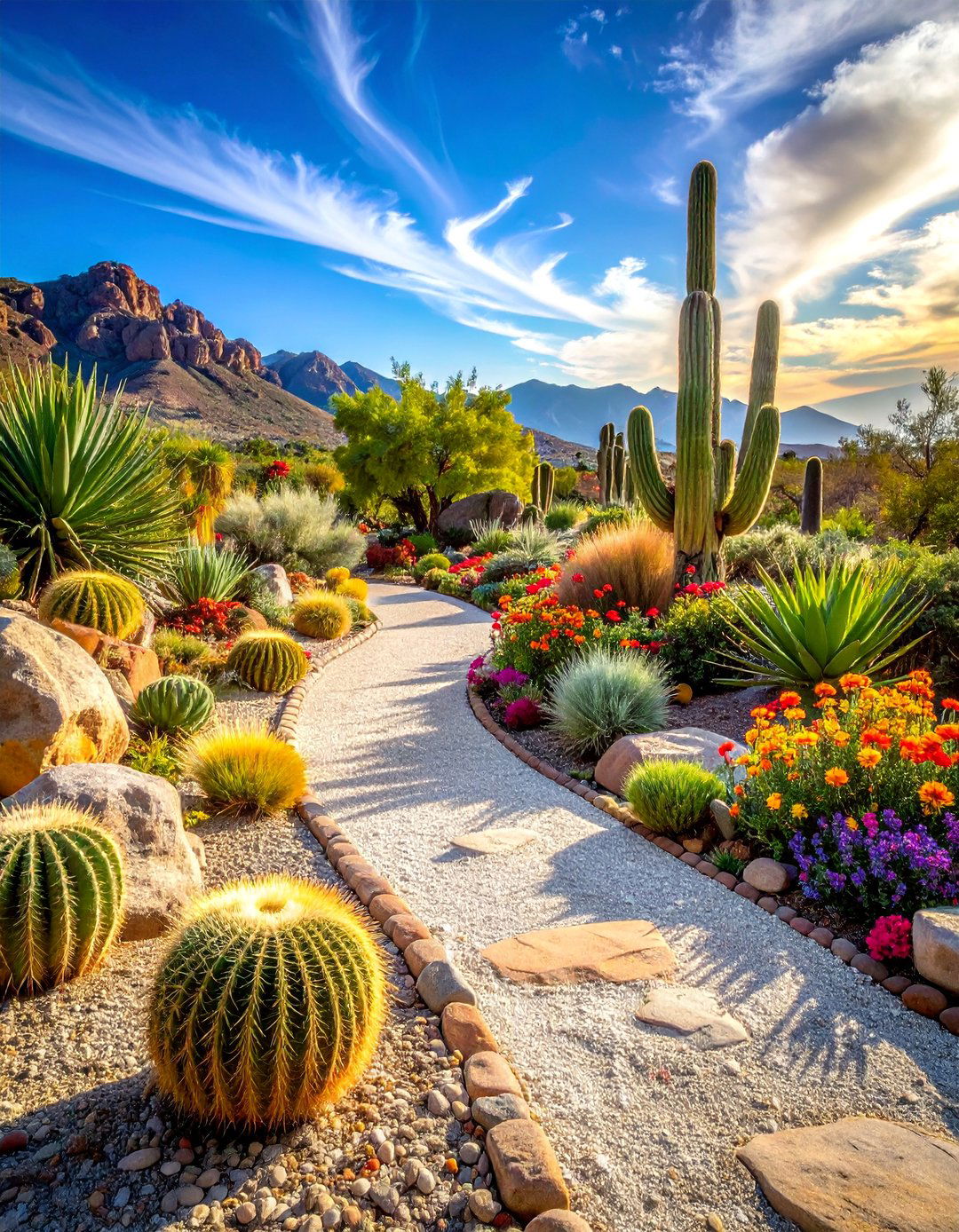
Could your garden thrive with minimal water while still creating breathtaking beauty? Desert gardens showcase the stunning forms and colors of drought-adapted plants like cacti, succulents, and native wildflowers. These water-wise landscapes feature decomposed granite pathways, boulder arrangements, and architectural plants with striking silhouettes. Flowering desert plants such as desert marigold, palo verde trees, and ocotillo provide seasonal color against neutral backgrounds. The design emphasizes natural stone materials, gravel mulches, and efficient irrigation systems. These gardens require minimal maintenance once established and support local wildlife adapted to arid conditions. Morning and evening lighting reveals the dramatic shadows and textures that make desert plants so visually compelling throughout the year.
7. Wildflower Meadow Gardens
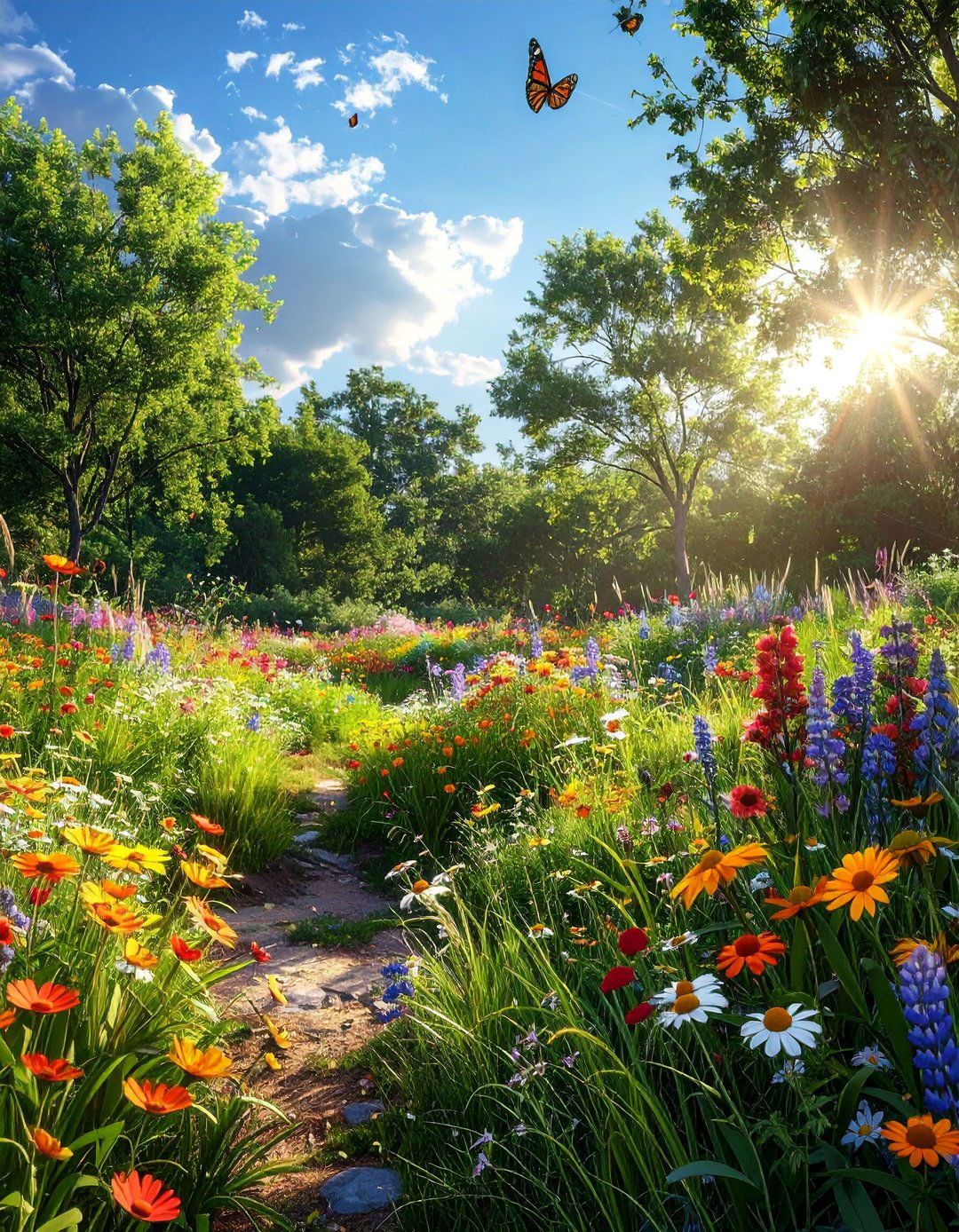
Wildflower meadows create naturalistic landscapes that support local wildlife while providing ever-changing seasonal beauty. These gardens feature native grasses mixed with regional wildflowers that bloom in succession throughout the growing season. Established meadows require minimal maintenance beyond annual cutting and occasional overseeding. The informal design approach allows plants to spread naturally, creating dynamic patterns that change from year to year. These gardens work particularly well on slopes or in areas too challenging for traditional landscaping. Butterflies, bees, and songbirds flock to wildflower meadows, creating living ecosystems in backyard spaces. The key to success lies in choosing plants adapted to local soil and climate conditions rather than fighting natural growing conditions.
8. Herb Kitchen Gardens
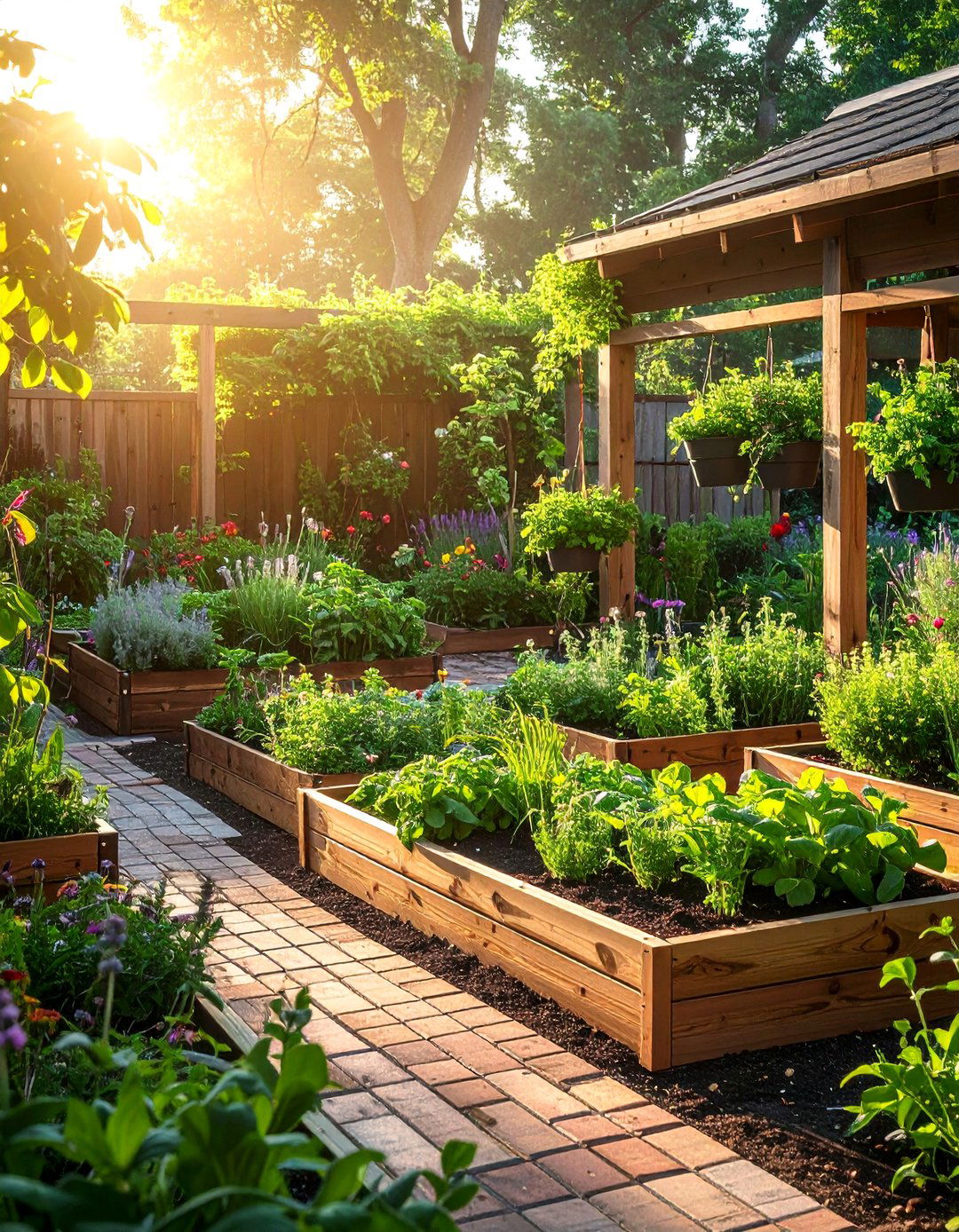
Kitchen herb gardens combine culinary functionality with ornamental beauty through carefully planned layouts near cooking areas. These productive spaces feature raised beds or container arrangements filled with essential cooking herbs like basil, oregano, thyme, and parsley. Companion plantings include edible flowers, small vegetables, and fruit-bearing plants that enhance both meals and garden aesthetics. Traditional herb gardens often follow formal patterns with brick or gravel pathways between planting areas. Modern interpretations embrace more relaxed designs while maintaining easy access for harvesting. These gardens provide fresh ingredients year-round through succession planting and season extension techniques. The fragrance and texture of herb plants create sensory experiences that make cooking and gardening more enjoyable and rewarding.
9. Vertical Living Walls
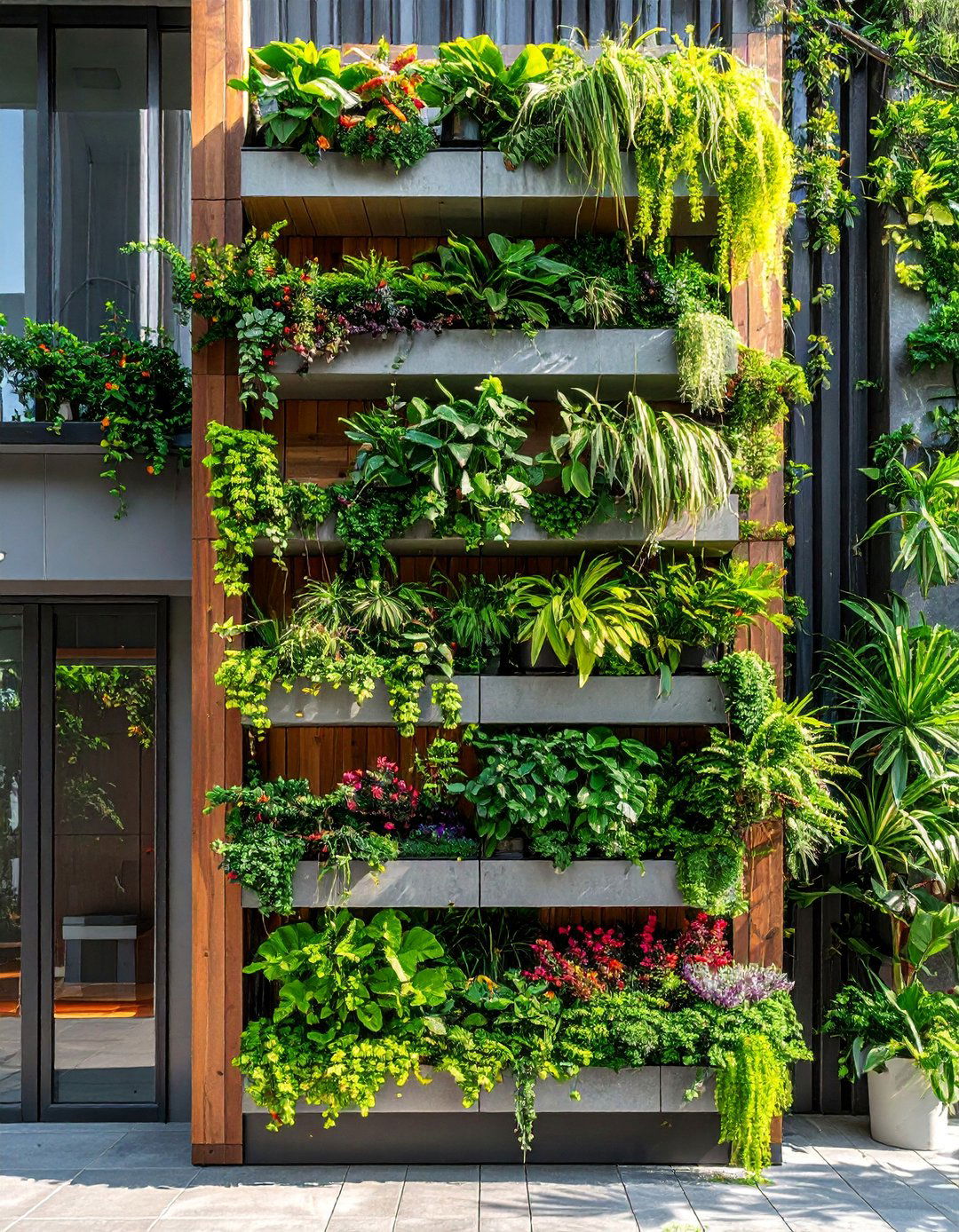
Vertical gardens maximize growing space in small areas through innovative planting systems mounted on walls or fences. These space-saving solutions work perfectly for urban balconies, small patios, or any location where ground space is limited. Modular planting systems allow easy plant changes and seasonal updates while maintaining structural integrity. Popular plants for vertical gardens include trailing varieties, herbs, small vegetables, and flowering annuals that create colorful displays. Proper irrigation systems ensure even water distribution throughout the vertical growing area. These gardens improve air quality while creating stunning living artwork on previously unused wall space. Maintenance involves regular watering, occasional fertilizing, and replacing plants as needed to maintain visual appeal throughout growing seasons.
10. Succulent Rock Gardens
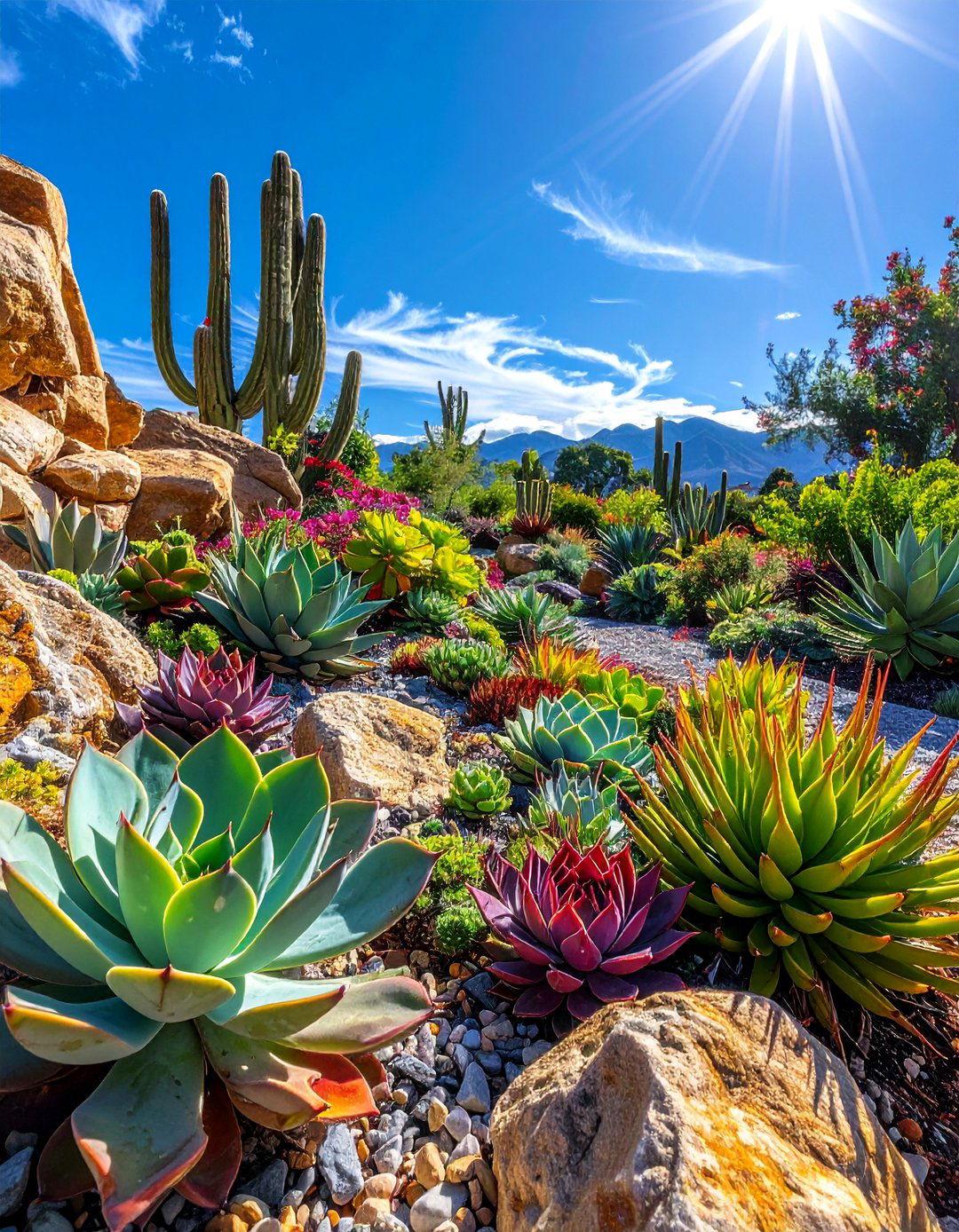
Are you looking for a low-maintenance garden that delivers maximum visual impact with minimal effort? Succulent gardens showcase the incredible diversity of drought-adapted plants through creative arrangements of various species and forms. These gardens feature well-draining soil amendments, decorative rock mulches, and container displays that highlight individual plant characteristics. Popular succulents include echeveria, sedum varieties, jade plants, and architectural agaves that provide year-round structure. The design often incorporates natural stone elements, driftwood, and sculptural containers that complement the plants' unique forms. These gardens thrive in sunny locations with minimal water requirements once established. Seasonal interest comes from flowering cycles and the subtle color changes many succulents display throughout the year.
11. Water Feature Gardens
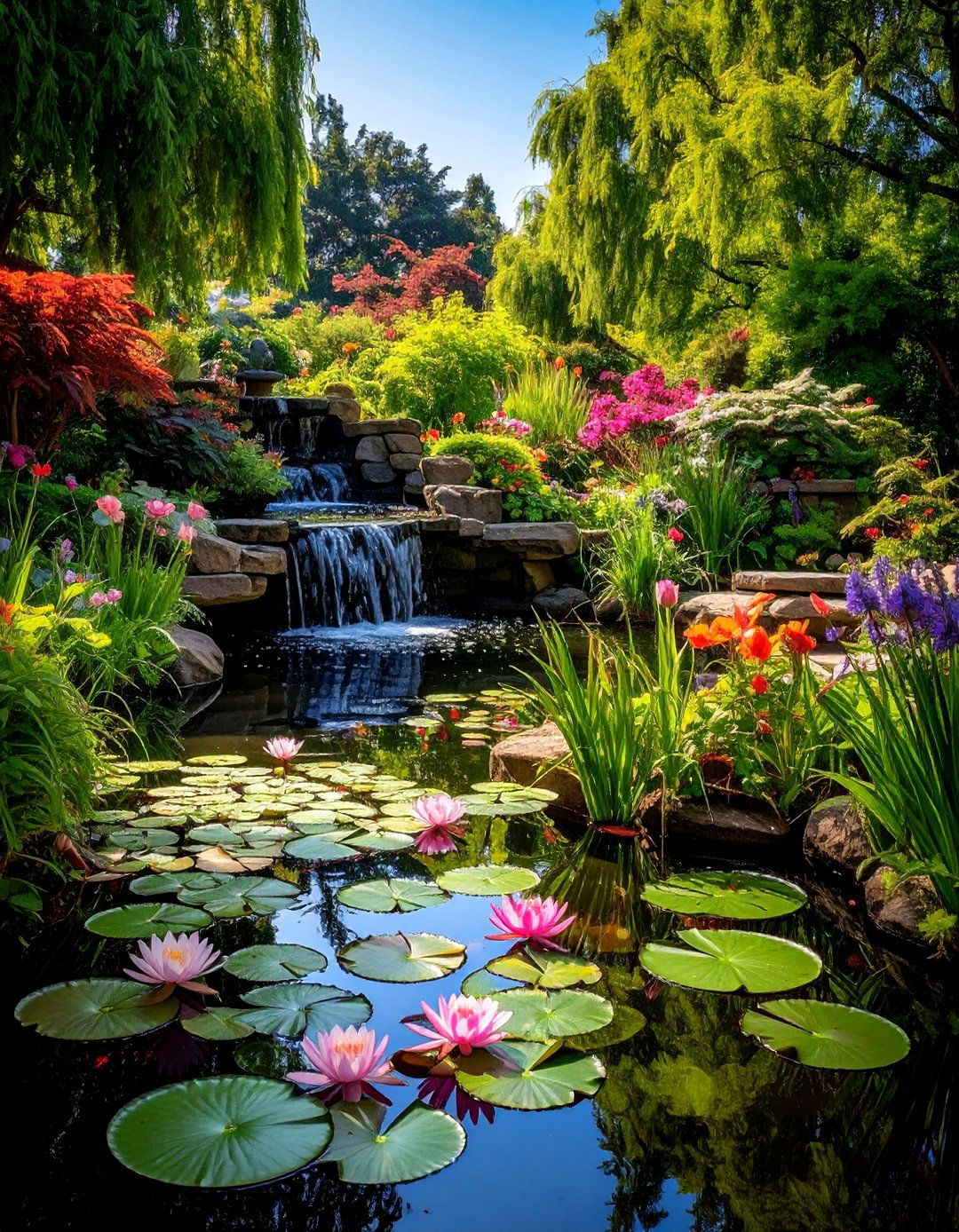
Water gardens create focal points through ponds, fountains, streams, or other aquatic features that add movement and sound to outdoor spaces. These gardens support aquatic plants like water lilies, lotus, and marginal plantings that create natural ecosystem balances. Fish populations add living interest while helping control mosquitoes and maintain water quality. The surrounding landscape typically features moisture-loving plants that complement the water theme. Design options range from formal geometric pools to naturalistic pond systems that mimic natural wetlands. Proper filtration and circulation systems maintain water clarity while supporting plant and animal life. These gardens provide cooling effects during hot weather while creating peaceful retreats for relaxation and contemplation.
12. Moon Gardens
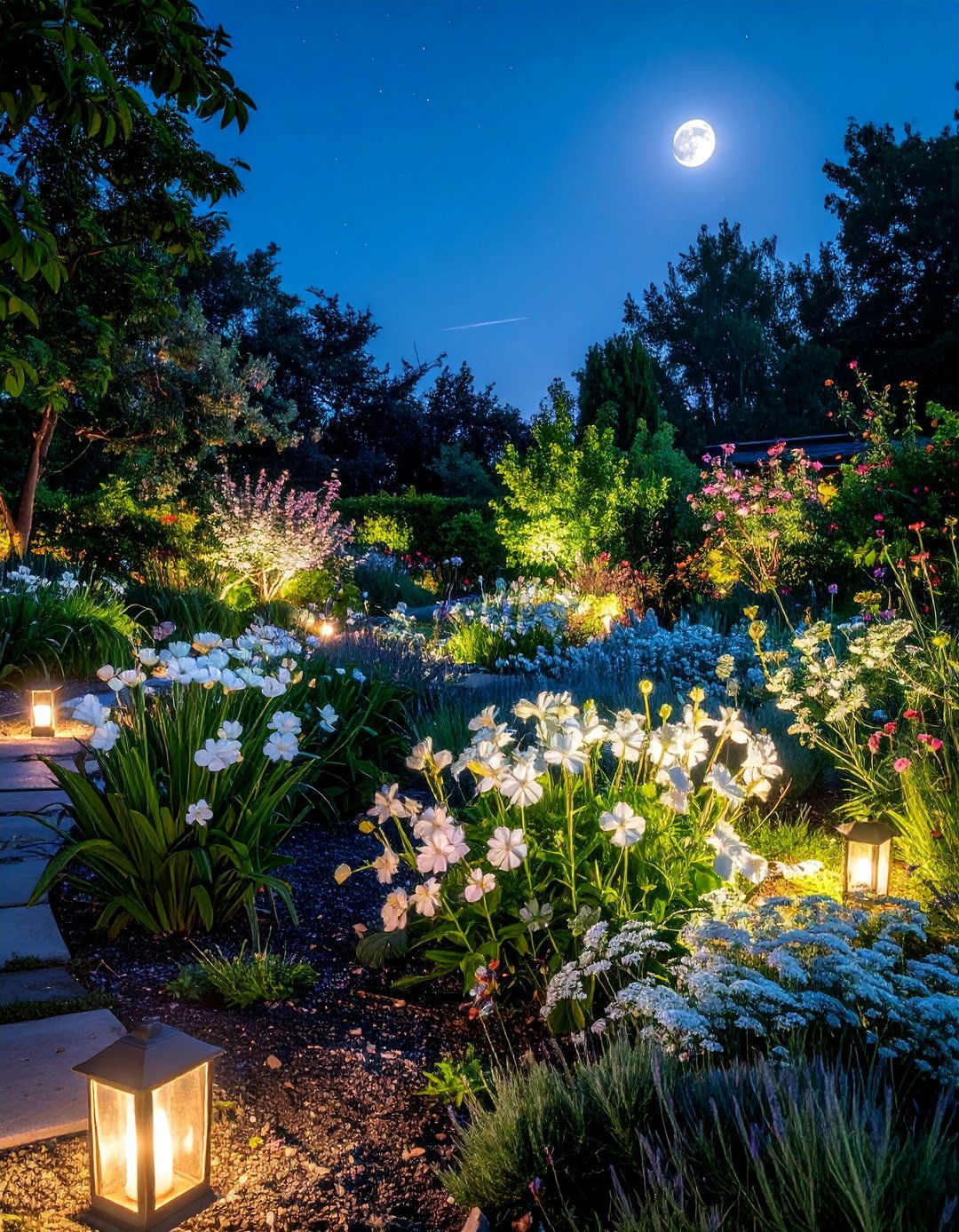
Moon gardens come alive during evening hours through white and silver-flowered plants that glow in moonlight and artificial illumination. These magical spaces feature night-blooming flowers like moonflowers, four o'clocks, and evening primrose that release intoxicating fragrances after dark. Silver-leaved plants such as lamb's ear, dusty miller, and artemisia reflect available light while providing textural contrast. Strategic lighting placement enhances the ethereal beauty while ensuring safe navigation along pathways. These gardens work particularly well near outdoor living areas where evening entertaining takes place. The design often includes comfortable seating arrangements positioned to appreciate the garden's nighttime transformation. Fragrant plants like night-blooming jasmine and sweet alyssum add another sensory dimension to the evening garden experience.
13. Butterfly Gardens
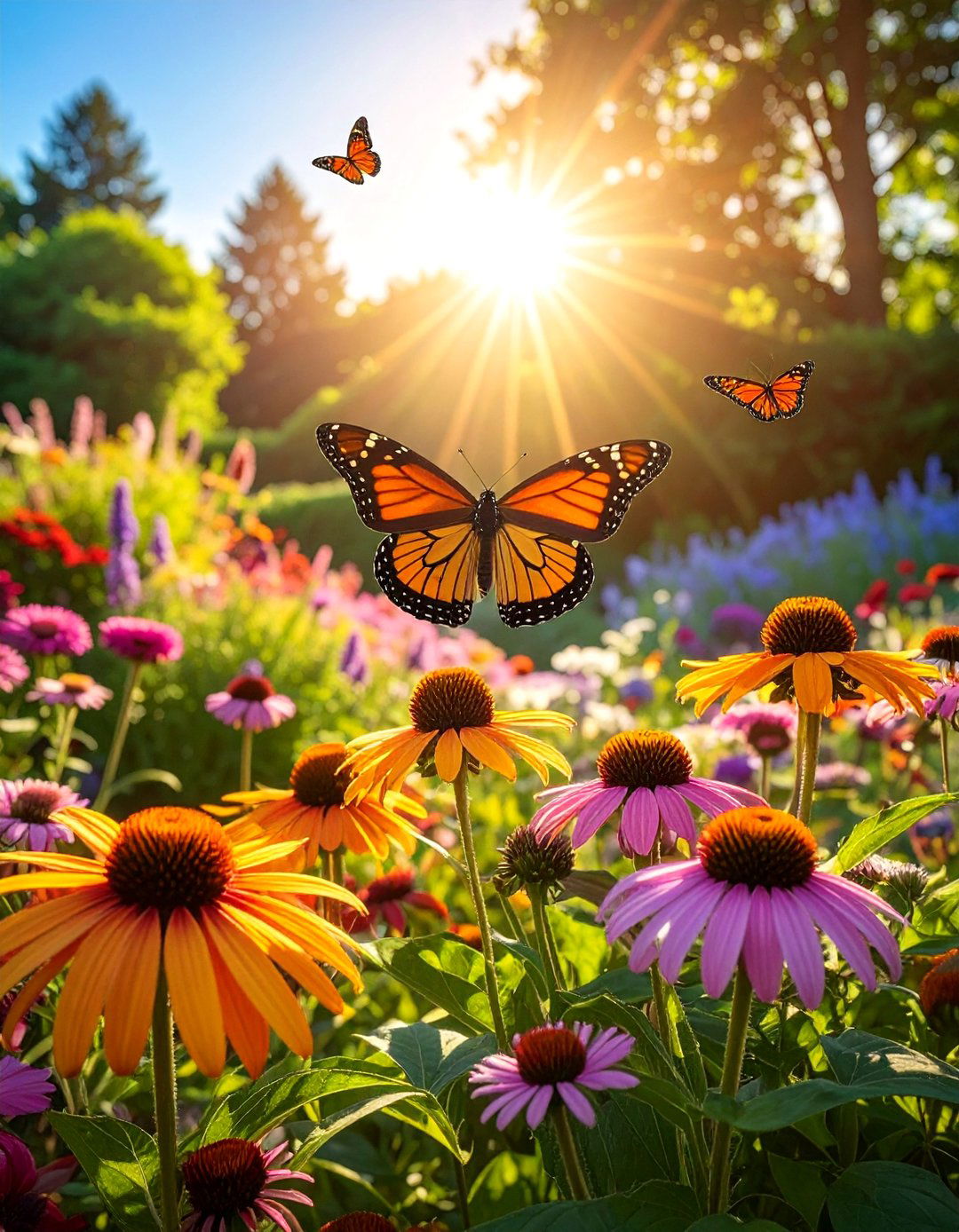
Butterfly gardens create havens for pollinators through carefully selected native plants that provide nectar sources and larval host plants. These ecological gardens feature flowers with flat or clustered blooms that accommodate butterfly feeding habits. Essential plants include butterfly bush, coneflowers, lantana, and milkweed varieties that support different butterfly species throughout their life cycles. The design incorporates sunny locations, wind protection, and shallow water sources that butterflies need for survival. These gardens require minimal pesticide use to maintain healthy pollinator populations. Seasonal planning ensures continuous bloom succession from spring through fall when butterflies are most active. The result creates living displays of color and movement that educate while entertaining garden visitors of all ages.
14. Shade Woodland Gardens
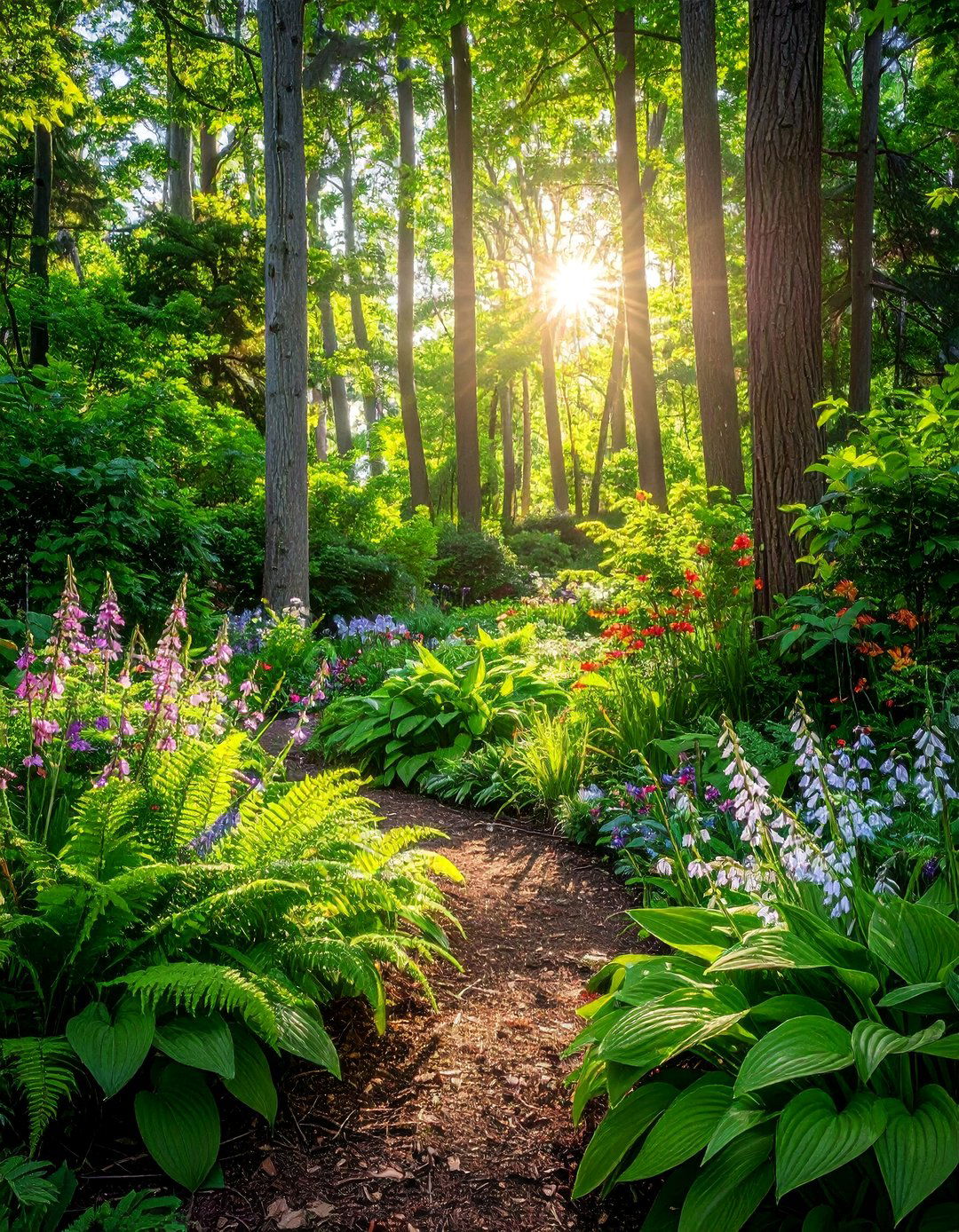
Woodland gardens transform challenging shaded areas into lush retreats filled with understory plants adapted to low-light conditions. These naturalistic spaces feature native trees, ferns, hostas, and wildflowers that create layered planting schemes. Spring ephemeral flowers like trilliums and bloodroot provide early season interest before tree canopies fully develop. The design emphasizes natural materials including mulched pathways, fallen log seating, and stone arrangements that blend with the forest setting. These gardens require minimal watering once established since most woodland plants prefer consistent moisture and organic-rich soils. The peaceful atmosphere makes woodland gardens perfect for meditation areas or quiet reading spots away from busy outdoor activities.
15. Rose Gardens
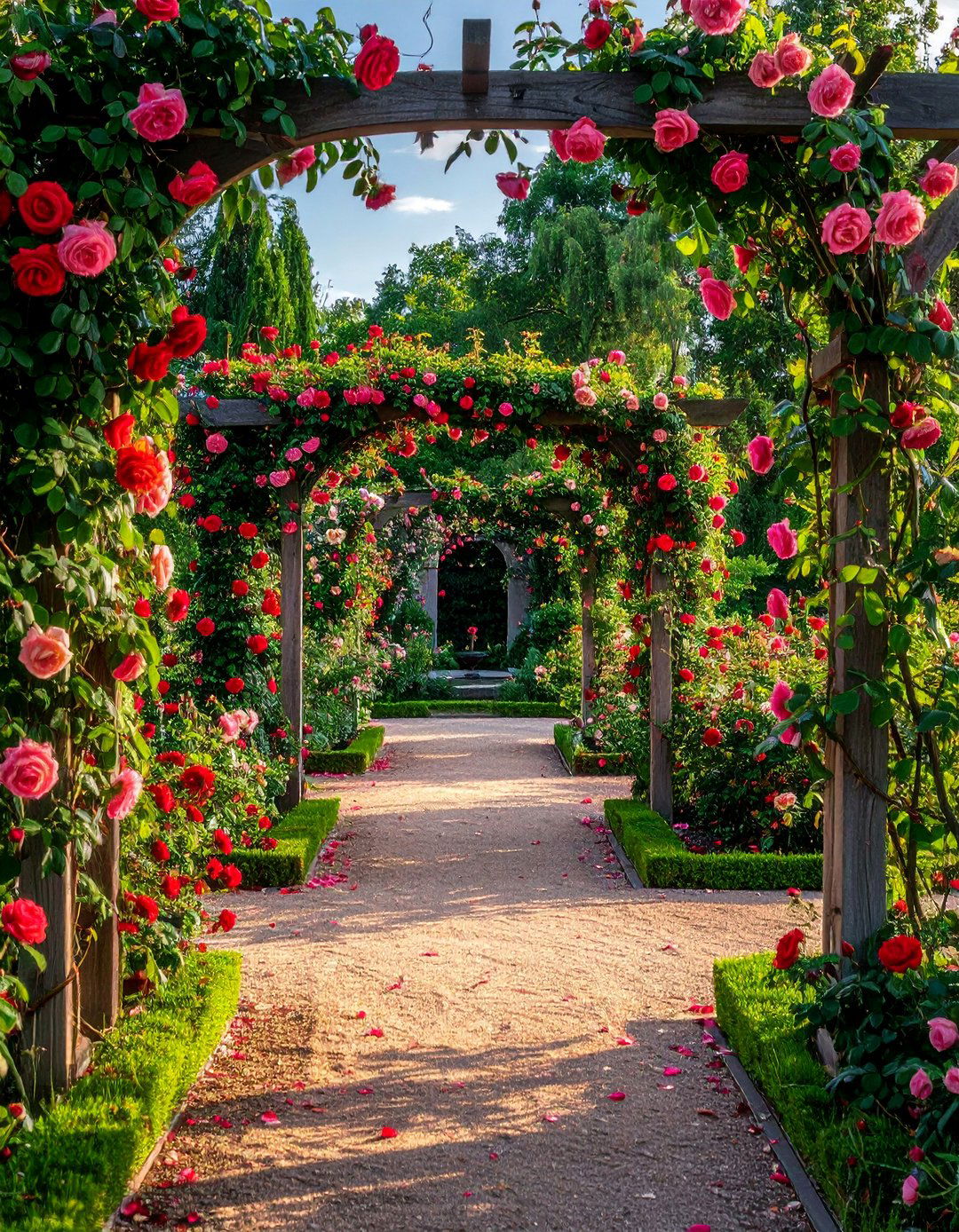
Do you dream of garden spaces filled with intoxicating fragrance and romantic blooms throughout the growing season? Rose gardens showcase the queen of flowers through specialized plantings that highlight different rose types and growing habits. These classic gardens feature hybrid teas, climbing varieties, shrub roses, and antique cultivars that provide diverse forms and flowering periods. Companion plantings include lavender, catmint, and other perennials that complement rose colors while supporting beneficial insects. The design often incorporates formal elements like arbors, pergolas, and geometric bed layouts that showcase roses effectively. Proper soil preparation, regular feeding, and disease management ensure healthy plants and abundant blooms. These gardens create romantic outdoor rooms perfect for entertaining or quiet contemplation among beautiful flowers.
16. Prairie Native Gardens
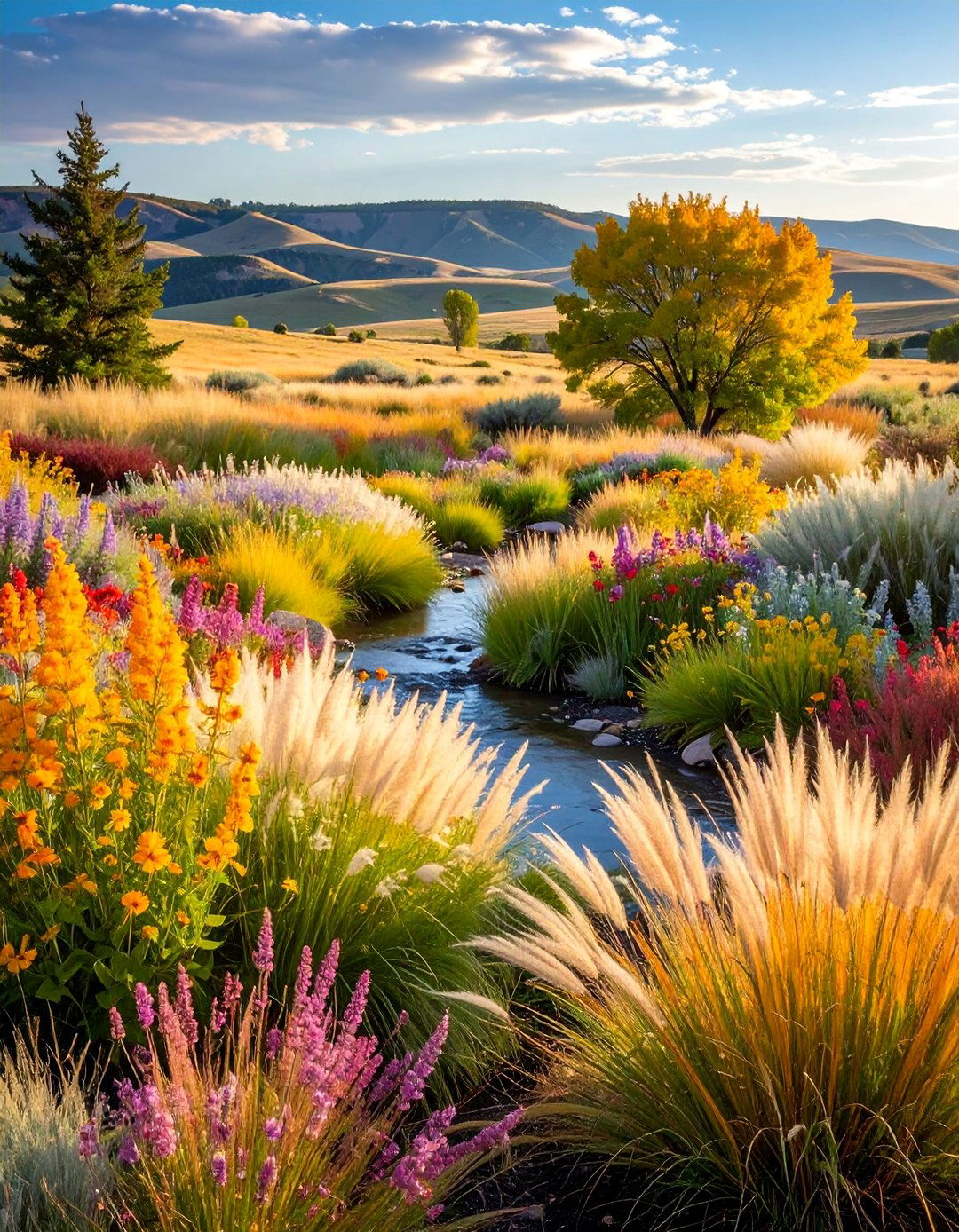
Prairie gardens celebrate regional ecosystems through native grasses and wildflowers that support local wildlife while requiring minimal maintenance. These sustainable landscapes feature warm-season grasses like little bluestem mixed with native flowering plants that provide year-round interest. The naturalistic design approach allows plants to form communities that change seasonally and annually. These gardens work particularly well in large areas where traditional lawn maintenance is challenging or undesirable. Wildlife benefits include habitat for birds, butterflies, and small mammals that depend on native plant communities. Establishment requires initial weed control and plant installation, but mature prairie gardens need only annual burning or cutting to maintain vigor. The result creates authentic landscapes that connect properties with regional natural heritage.
17. Formal Geometric Gardens
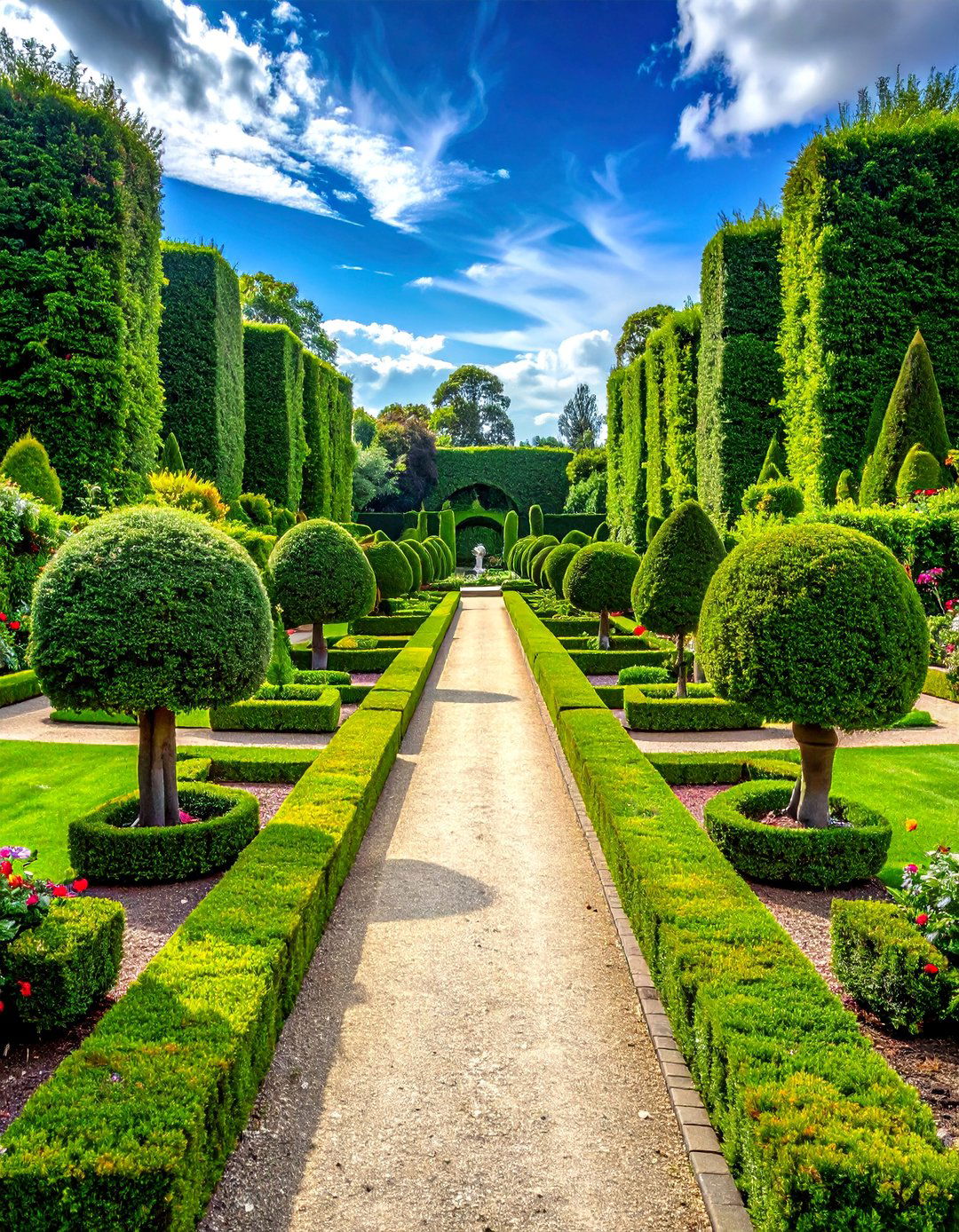
Formal gardens create sophisticated outdoor rooms through symmetrical layouts, clipped hedges, and geometric planting patterns. These structured spaces feature precise plant arrangements that emphasize order and classical design principles. Topiary specimens, formal water features, and carefully maintained lawn areas contribute to the refined aesthetic. The plant palette typically includes evergreen shrubs, seasonal annuals, and perennials that maintain neat appearances throughout growing seasons. These gardens require regular maintenance including pruning, edging, and replanting to preserve their crisp appearance. The design works particularly well with traditional or classical architecture where formal landscapes complement building styles. Pathways, seating areas, and focal points follow geometric principles that create balanced and harmonious outdoor environments.
18. Children's Play Gardens
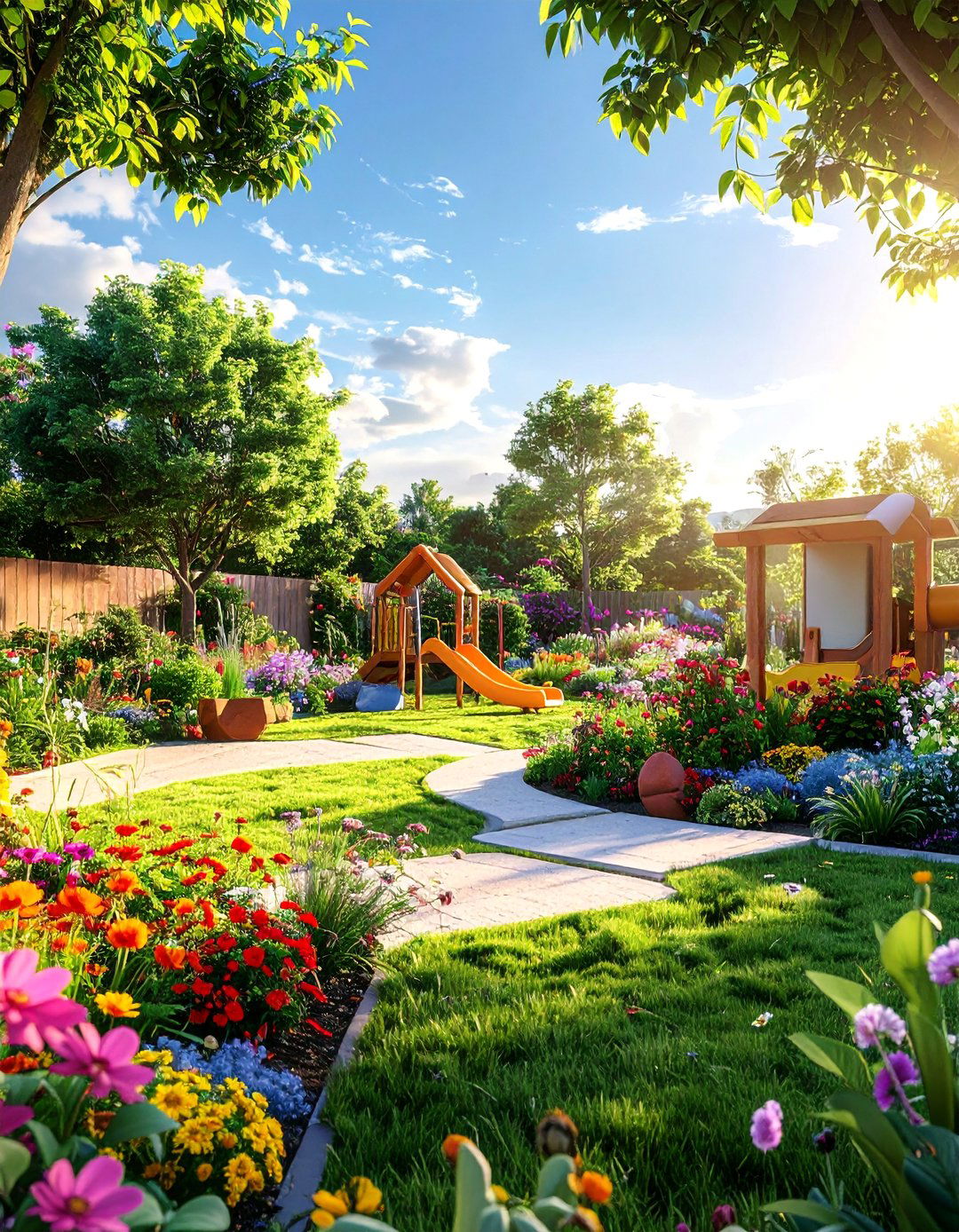
Children's gardens combine educational opportunities with safe outdoor play areas that encourage exploration and learning. These family-friendly spaces feature durable plants, designated digging areas, and interactive elements like sundials or weather stations. Plant selections emphasize quick-growing varieties, sensory plants with interesting textures or fragrances, and edible crops that teach children about food production. Safety considerations include avoiding toxic plants, creating clear sightlines, and using organic gardening practices. The design often incorporates themed areas like fairy gardens, dinosaur landscapes, or pirate hideouts that spark imagination. These gardens provide hands-on learning opportunities while fostering appreciation for nature and outdoor activities. Regular involvement in garden maintenance teaches responsibility while creating lasting family memories.
19. Cutting Flower Gardens
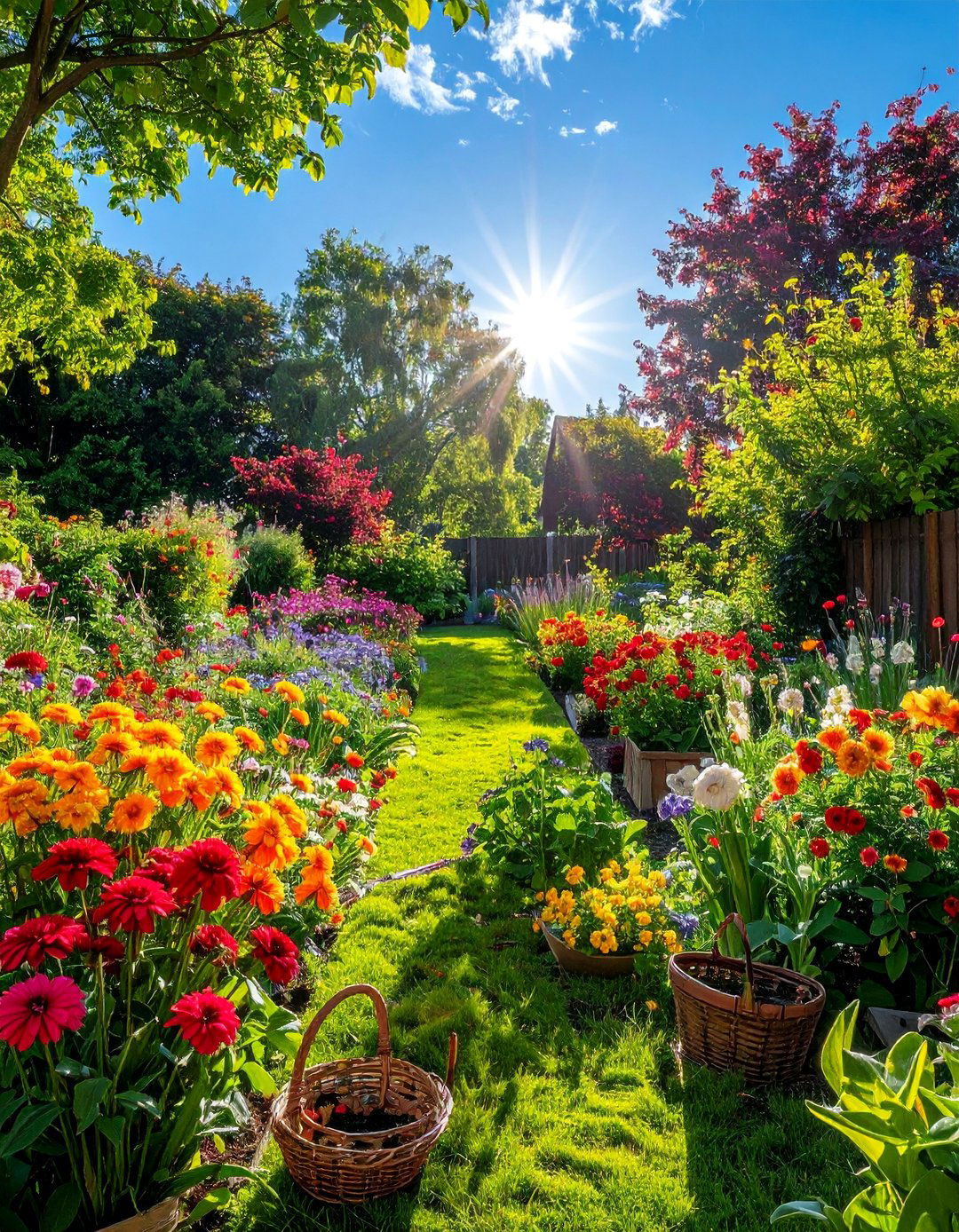
Have you ever wanted to create stunning bouquets using flowers grown in your own backyard? Cutting gardens provide abundant flowers for indoor arrangements through specialized plantings designed for harvest rather than landscape display. These productive spaces feature annual and perennial flowers chosen for their long stems, extended vase life, and continuous blooming habits. Popular cutting flowers include zinnias, cosmos, sunflowers, delphiniums, and dahlias that provide diverse colors and forms. The design emphasizes accessibility with wide pathways and organized rows that facilitate harvesting and maintenance. These gardens often include utility areas with potting benches, storage, and water access for flower conditioning. Succession planting ensures continuous bloom production throughout the growing season for consistent flower availability.
20. Rooftop Urban Gardens
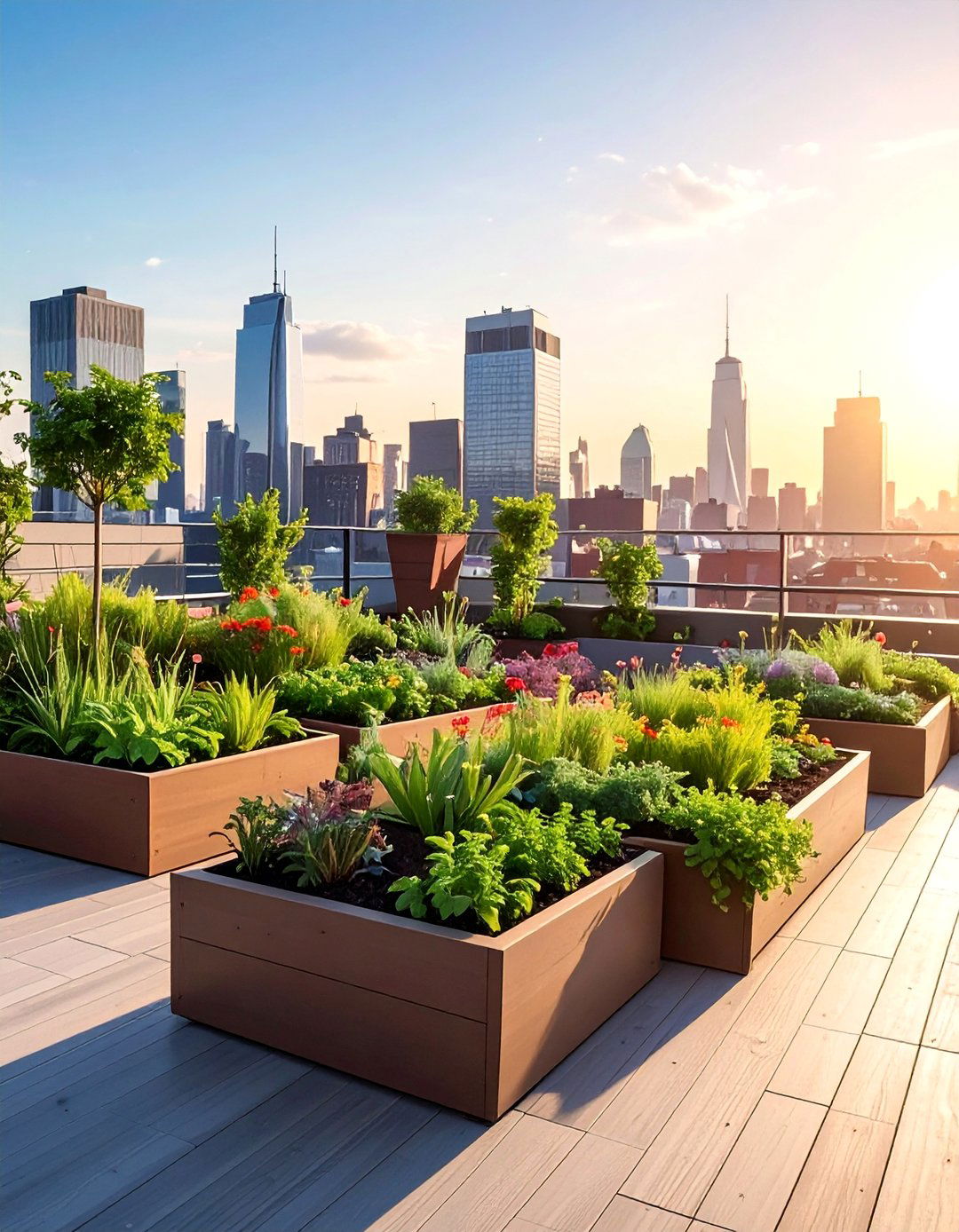
Rooftop gardens transform unused urban spaces into productive growing areas that provide food, beauty, and environmental benefits. These challenging environments require specialized planning for wind exposure, weight limitations, and extreme temperature fluctuations. Container systems, lightweight growing media, and efficient irrigation make rooftop cultivation possible in dense urban settings. Plant selections emphasize wind-resistant varieties, compact forms, and species adapted to container culture. These gardens provide fresh produce, reduce building energy costs, and create pleasant outdoor spaces in urban environments. The design often incorporates seating areas, privacy screens, and weather protection that make rooftops usable throughout growing seasons. Maintenance considerations include regular watering, wind protection, and seasonal plant replacement to maintain productivity and appearance.
21. Rain Gardens
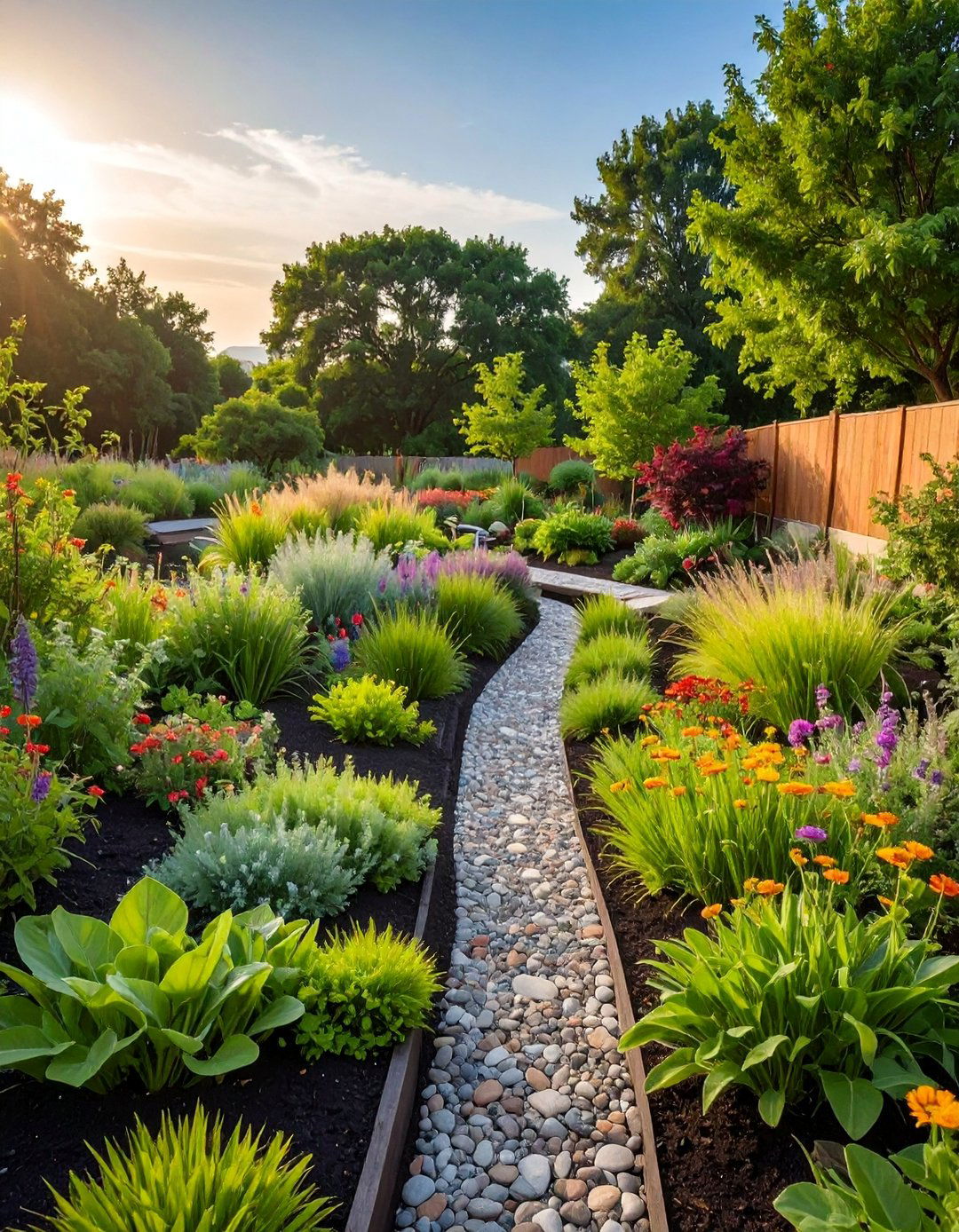
Rain gardens manage stormwater runoff while creating beautiful planted areas that support local ecosystems. These functional landscapes feature depression areas planted with native species that tolerate both wet and dry conditions. The design captures rainwater from roofs, driveways, and other hard surfaces, allowing slow infiltration that reduces erosion and flooding. Plants selections include native sedges, wildflowers, and shrubs that thrive in fluctuating moisture conditions. These gardens provide habitat for wildlife while improving water quality through natural filtration processes. Installation requires proper grading, soil amendments, and plant establishment during appropriate seasons. The result creates attractive landscape features that solve practical problems while supporting environmental stewardship goals throughout communities.
22. Balcony Container Gardens
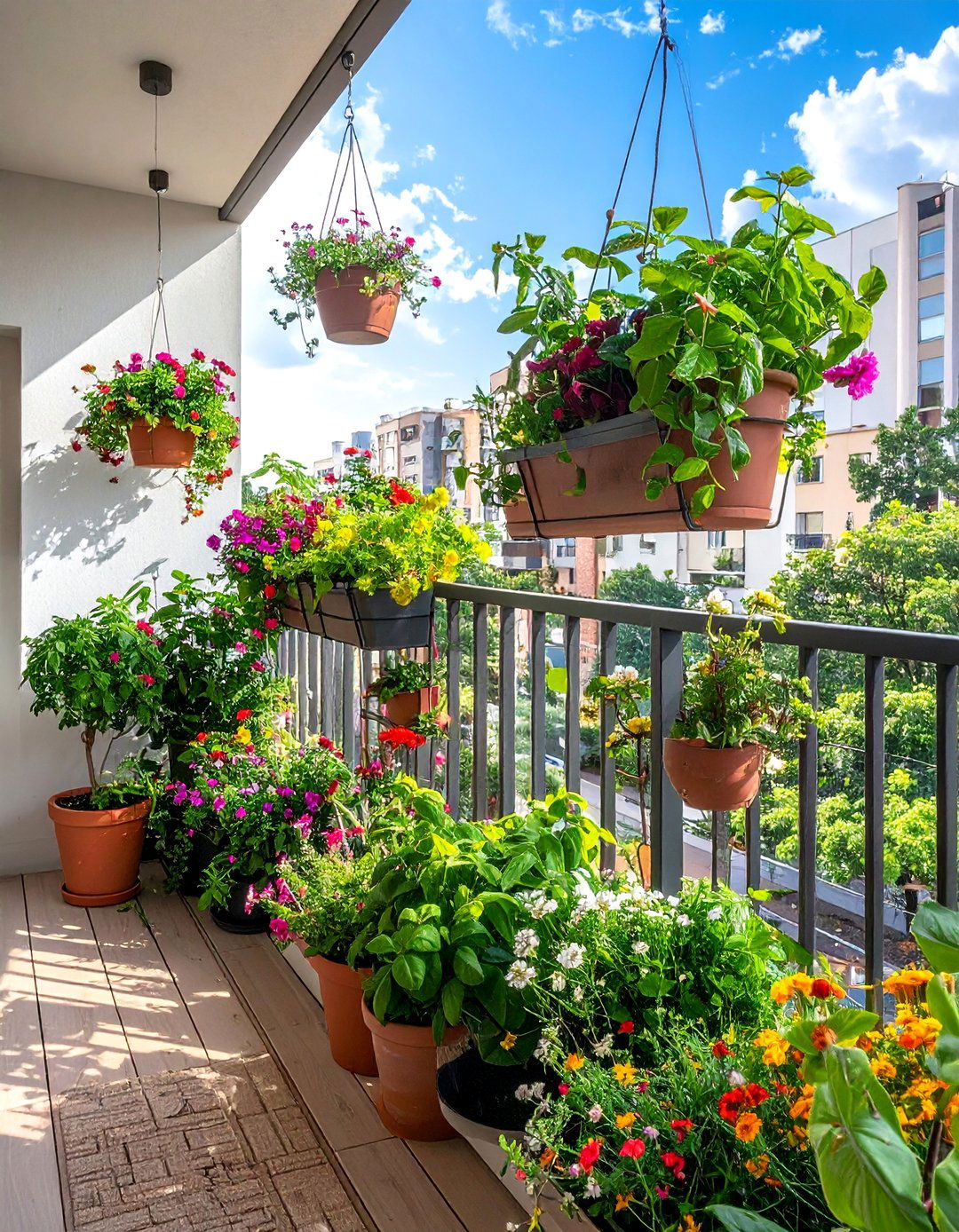
Balcony gardens maximize limited space through creative container arrangements that provide growing opportunities in urban apartments and condominiums. These portable gardens feature lightweight containers, trailing plants, and vertical growing systems that make efficient use of available space. Plant selections emphasize compact varieties, wind tolerance, and species suitable for container culture throughout growing seasons. The design considerations include weight restrictions, drainage requirements, and access to water sources for regular maintenance. These gardens provide fresh herbs, vegetables, and flowers while creating pleasant outdoor living spaces in urban environments. Seasonal changes allow experimentation with different plant combinations and container arrangements. Regular maintenance includes watering, fertilizing, and plant replacement to maintain health and visual appeal.
23. Sensory Gardens
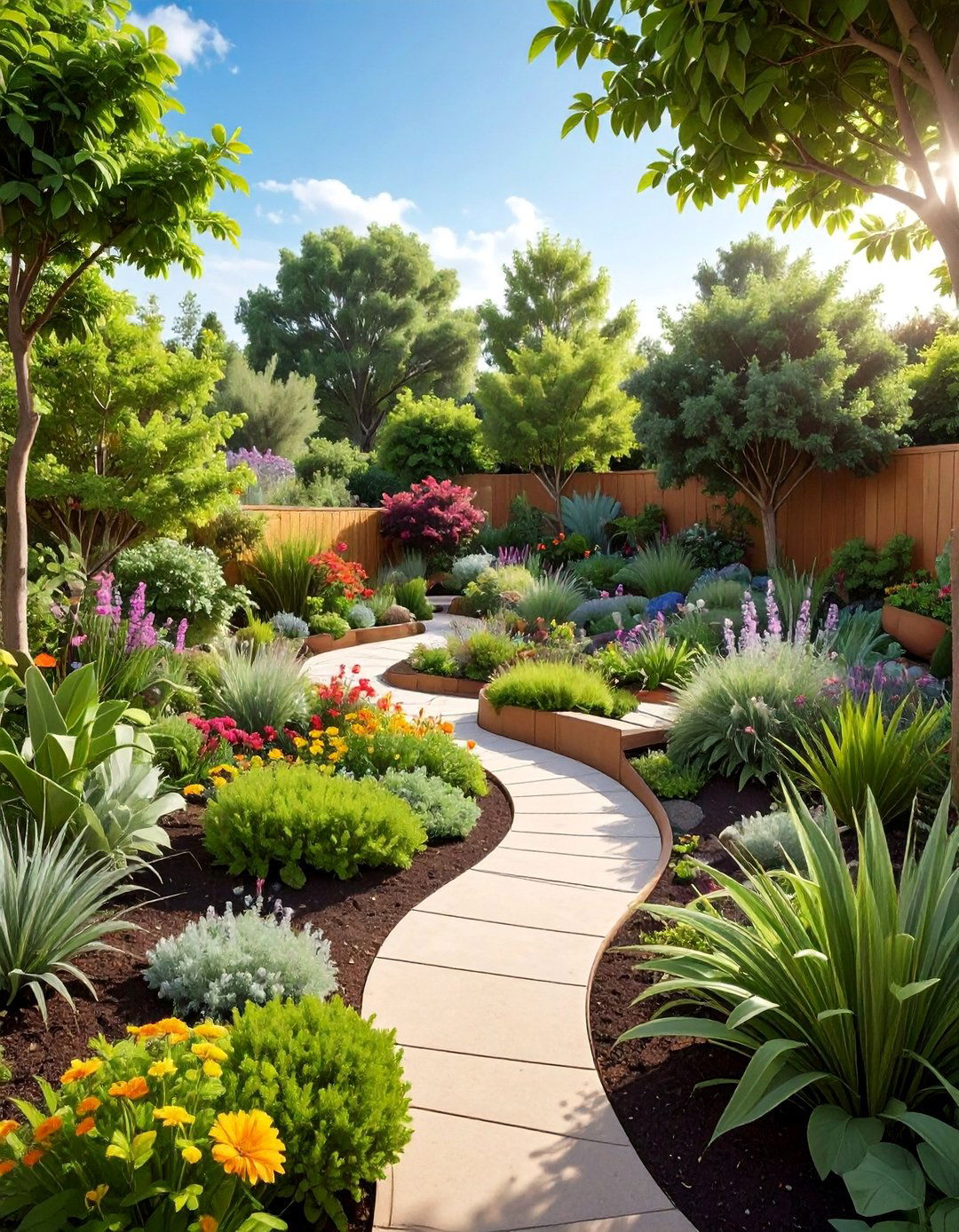
Can you imagine a garden designed specifically to engage all five senses through carefully chosen plants and design elements? Sensory gardens create immersive experiences through plants selected for their textures, fragrances, sounds, and visual qualities. These therapeutic spaces feature soft lamb's ear leaves, fragrant herbs like rosemary and mint, and ornamental grasses that rustle in breezes. Edible plants provide taste experiences while colorful flowers stimulate visual senses throughout growing seasons. The design includes accessible pathways, comfortable seating, and interactive elements that encourage exploration and engagement. These gardens provide particular benefits for elderly individuals, children, and people with disabilities who enjoy enhanced sensory experiences. Maintenance focuses on keeping plants healthy and accessible while preserving the intended sensory qualities.
24. Alpine Rock Gardens
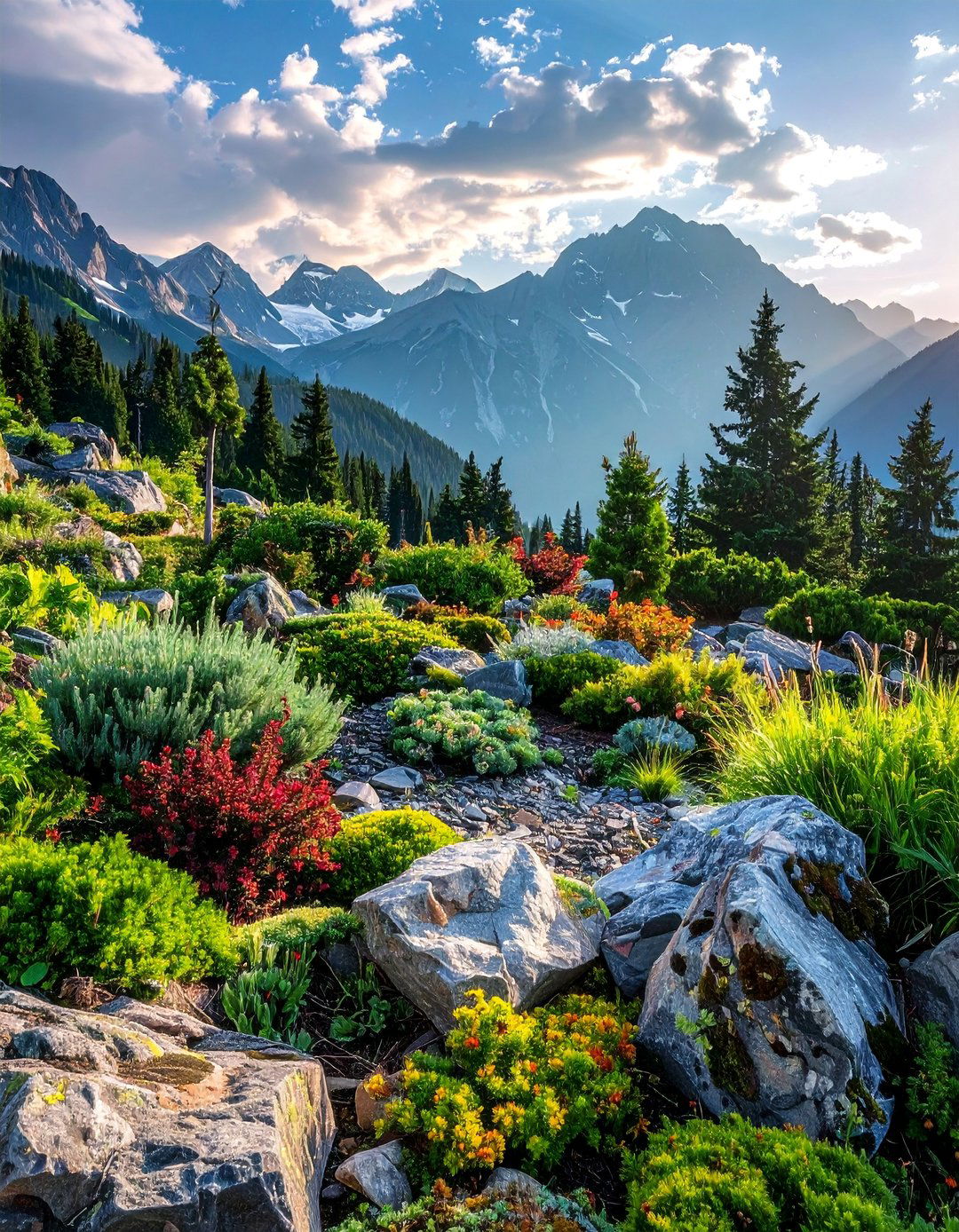
Alpine gardens recreate mountain environments through specialized plantings in rocky, well-drained settings that showcase high-altitude plant adaptations. These challenging gardens feature alpine plants, dwarf conifers, and rock garden perennials that thrive in harsh conditions with excellent drainage. The construction requires careful stone placement, specialized soil mixes, and attention to drainage details that prevent water accumulation. Plant selections emphasize compact forms, interesting textures, and species adapted to extreme weather conditions. These gardens provide year-round interest through evergreen plants, seasonal flowers, and structural elements that remain attractive during dormant periods. The design often incorporates natural stone arrangements that create microclimates for different plant requirements. Maintenance involves careful watering, weed control, and occasional plant replacement to maintain authentic alpine character.
25. Mediterranean Herb Gardens
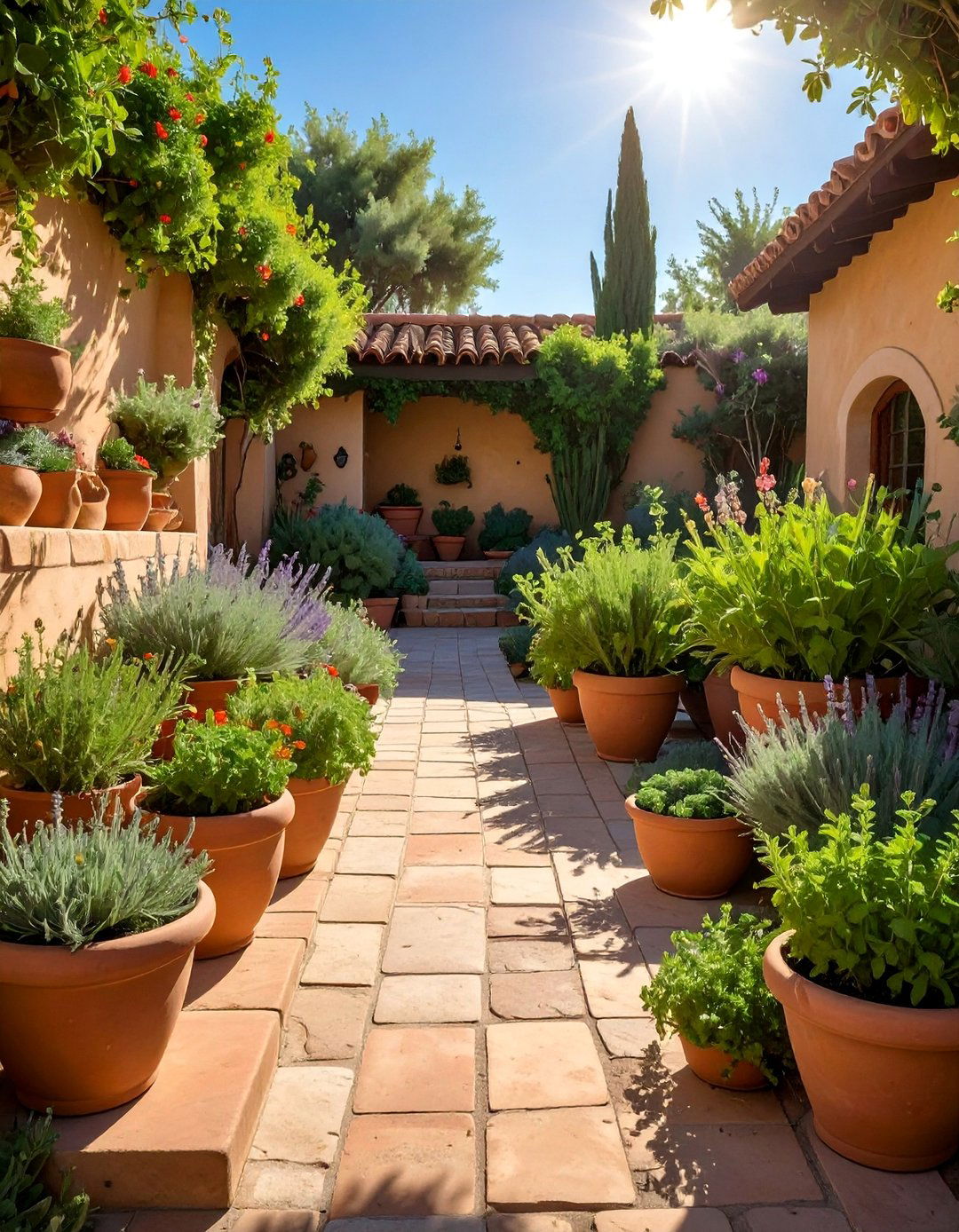
Mediterranean herb gardens combine culinary functionality with drought-tolerant beauty through plantings of aromatic herbs native to southern European climates. These water-wise spaces feature rosemary, thyme, oregano, sage, and lavender arranged in informal groupings or formal patterns. The design emphasizes well-drained soils, full sun exposure, and natural materials like terracotta containers and stone pathways. These gardens provide fresh cooking ingredients while creating fragrant outdoor spaces that attract beneficial insects. Plant selections thrive in hot, dry conditions while requiring minimal supplemental watering once established. The harvest potential includes fresh herbs throughout growing seasons plus dried herbs for winter use. Regular harvesting and light pruning maintain plant health while ensuring continuous production.
26. Cottage Vegetable Gardens
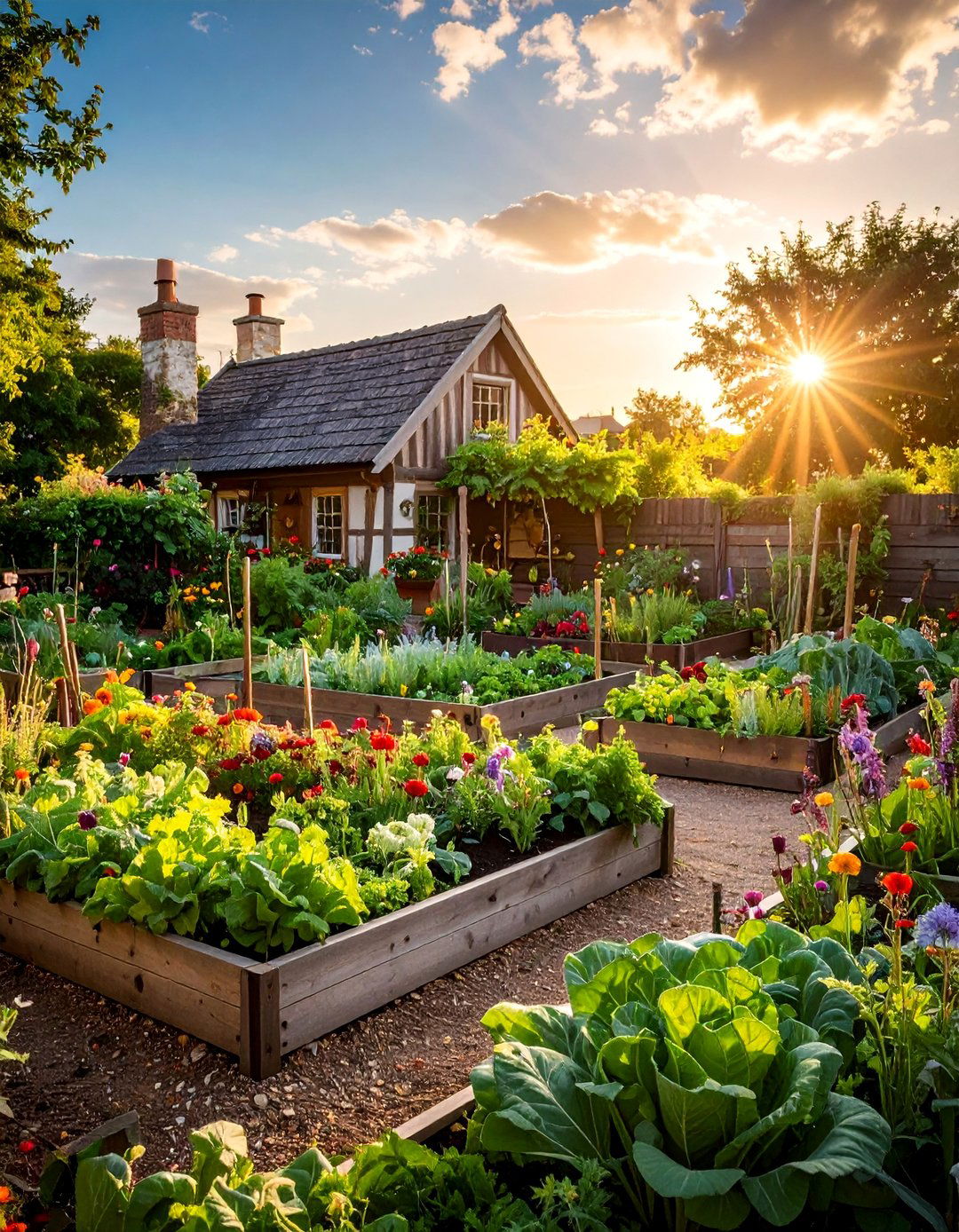
What could be more satisfying than growing your own organic vegetables in a beautiful garden setting? Cottage vegetable gardens blend productive growing with ornamental appeal through mixed plantings of vegetables, herbs, and flowers. These charming spaces feature raised beds, rustic materials, and informal layouts that accommodate diverse plant types and growing requirements. Companion planting strategies use flowers to attract beneficial insects while herbs provide natural pest control. The design includes pathways for easy access, composting areas, and tool storage that support productive gardening activities. These gardens provide fresh food while creating attractive landscape features that change seasonally. Succession planting ensures continuous harvests while crop rotation maintains soil health and prevents pest problems throughout growing seasons.
27. Native Wildlife Gardens
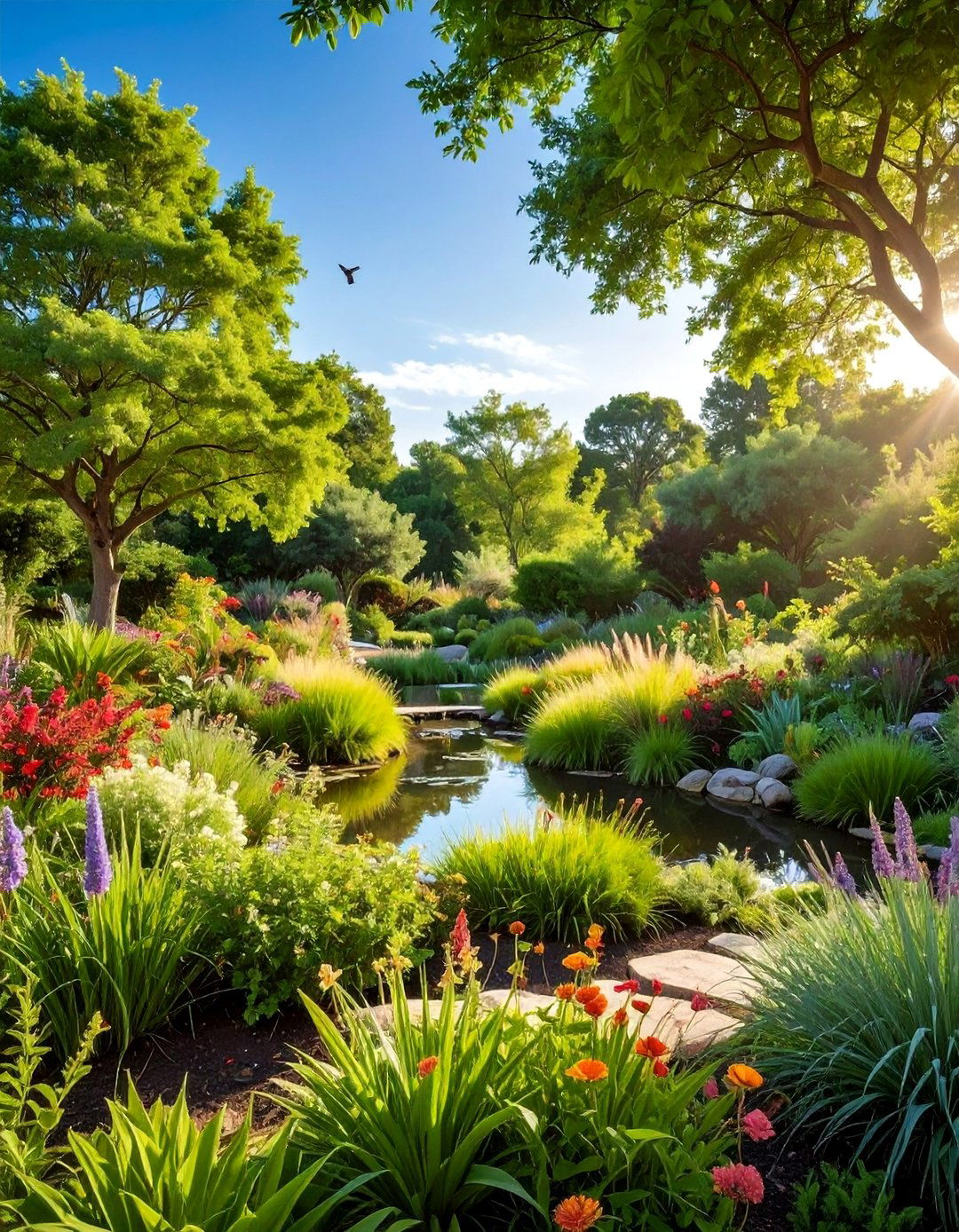
Native wildlife gardens support local ecosystems through indigenous plant communities that provide food, shelter, and nesting sites for regional animals. These ecological landscapes feature trees, shrubs, and perennials that have evolved with local wildlife species over thousands of years. The design emphasizes plant diversity, natural arrangements, and minimal human intervention that allows natural processes to establish balanced communities. These gardens require less water, fertilizer, and pest control since native plants are adapted to local conditions. Wildlife benefits include habitat for birds, butterflies, small mammals, and beneficial insects that support healthy ecosystems. The result creates authentic landscapes that educate while demonstrating sustainable gardening practices. Maintenance involves occasional weeding and plant establishment rather than intensive care requirements.
28. Urban Pollinator Gardens
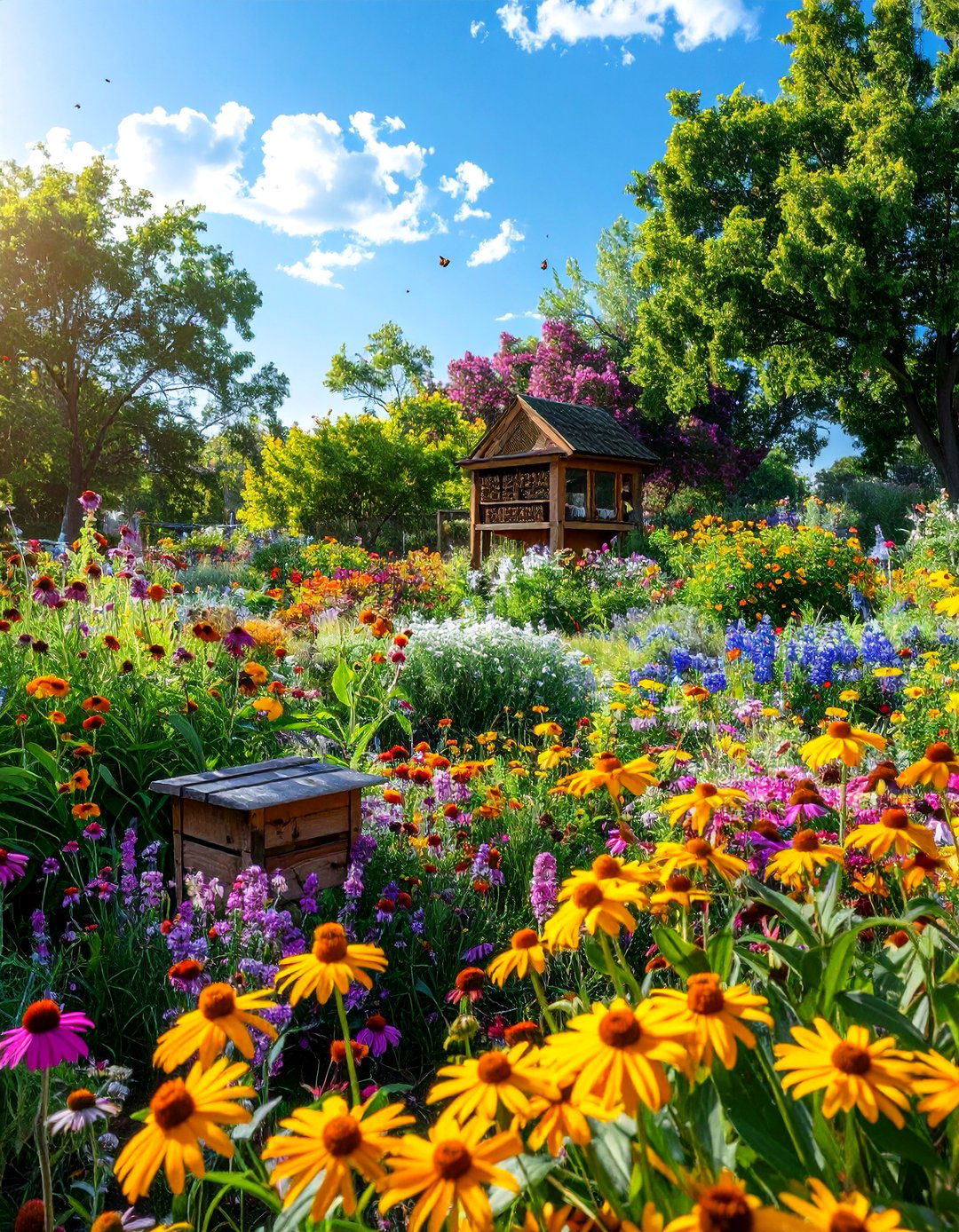
Urban pollinator gardens create essential habitat for bees, butterflies, and other beneficial insects in city environments where natural areas are limited. These ecological spaces feature native flowering plants that provide nectar sources throughout entire growing seasons. Plant selections emphasize diverse bloom times, flower shapes, and species that support different pollinator types. The design avoids pesticide use while incorporating nesting sites and overwintering habitat that support complete pollinator life cycles. These gardens provide environmental benefits while creating beautiful displays of seasonal flowers and activity. Educational opportunities include observing pollinator behavior and learning about ecological relationships between plants and animals. Maintenance focuses on organic practices that support beneficial insect populations while maintaining attractive garden appearance.
29. Edible Landscape Gardens
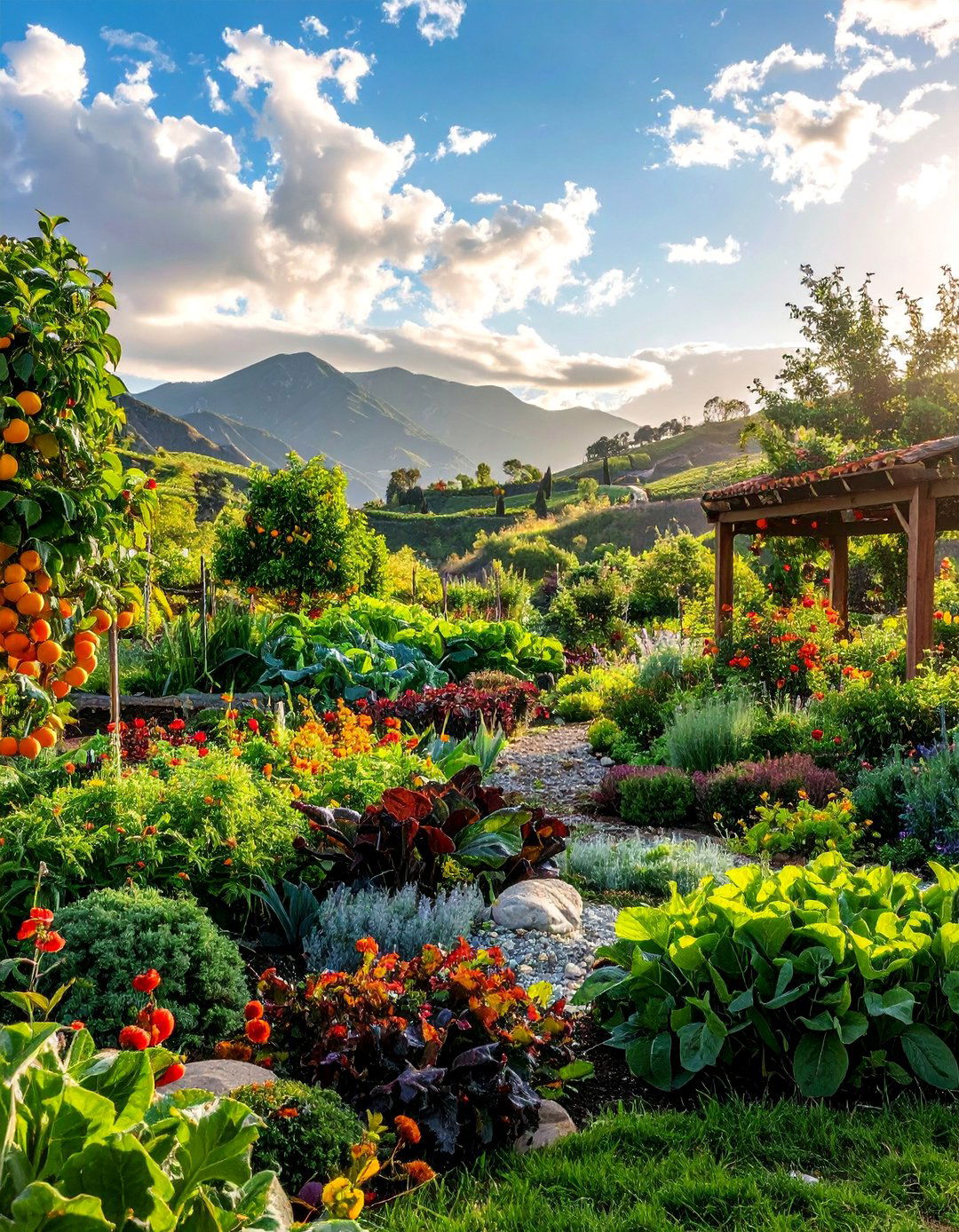
Do you love the idea of growing food that also creates beautiful ornamental landscapes? Edible landscapes integrate fruit trees, vegetable plants, and culinary herbs into attractive garden designs that provide both beauty and sustenance. These productive spaces feature espaliered fruit trees, ornamental vegetables like rainbow chard, and flowering herbs that serve dual purposes. The design principles follow traditional landscape approaches while emphasizing plants that offer edible harvests. These gardens reduce food costs while providing ultra-fresh ingredients for cooking and preserving. Plant selections consider seasonal interest, growth habits, and harvest timing to maintain year-round appeal. Maintenance includes regular harvesting, seasonal planting, and organic care practices that ensure food safety while maintaining garden health.
30. Container Water Gardens
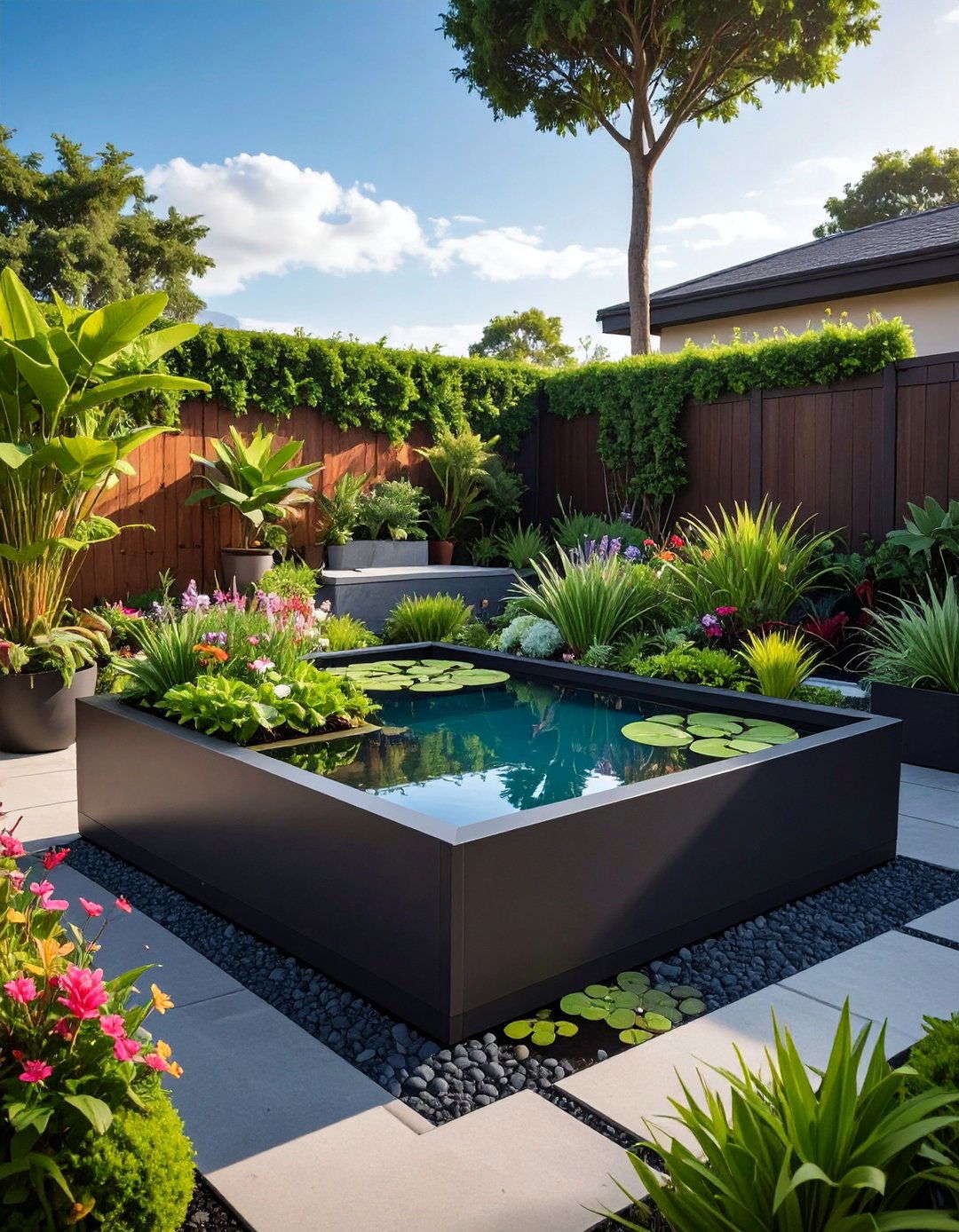
Container water gardens bring aquatic beauty to small spaces through portable pond systems that fit patios, balconies, and urban settings. These versatile features use large containers, half-barrels, or specialized pond systems that support water plants and small fish populations. Plant selections include floating varieties like water hyacinth, marginal plants such as water iris, and submerged species that maintain water quality. The design considerations include proper sizing, filtration needs, and seasonal care requirements for aquatic systems. These gardens provide cooling effects, wildlife habitat, and peaceful water sounds in limited spaces. Winter protection may require moving containers to protected areas or using heating systems to prevent freezing. Maintenance involves water level monitoring, plant care, and seasonal cleaning to maintain healthy aquatic environments.
31. Fragrance Gardens
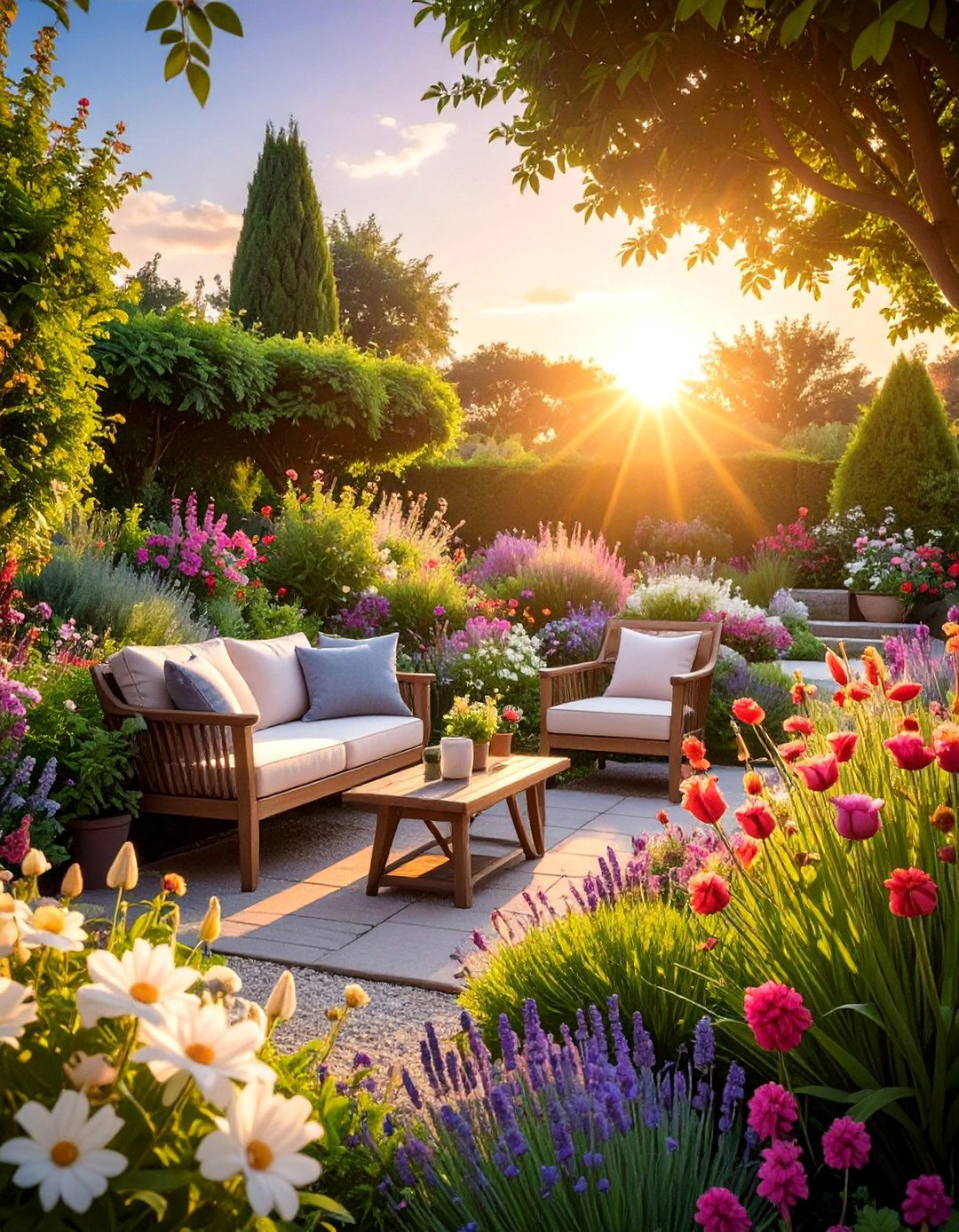
Fragrance gardens create aromatic outdoor experiences through plants selected specifically for their scented flowers, foliage, or other plant parts. These sensory spaces feature jasmine, gardenias, sweet peas, and other intensely fragrant species arranged near seating areas and pathways. The design considers bloom timing to ensure continuous fragrance throughout growing seasons while accommodating different plant requirements. Evening-blooming varieties like four o'clocks and moonflowers extend aromatic experiences into nighttime hours. These gardens provide therapeutic benefits while creating memorable outdoor experiences for family and guests. Plant placement emphasizes wind patterns and air circulation that carry fragrances effectively throughout garden spaces. Maintenance includes deadheading spent flowers, proper fertilization, and seasonal care that maintains optimal flowering and fragrance production.
32. Miniature Fairy Gardens
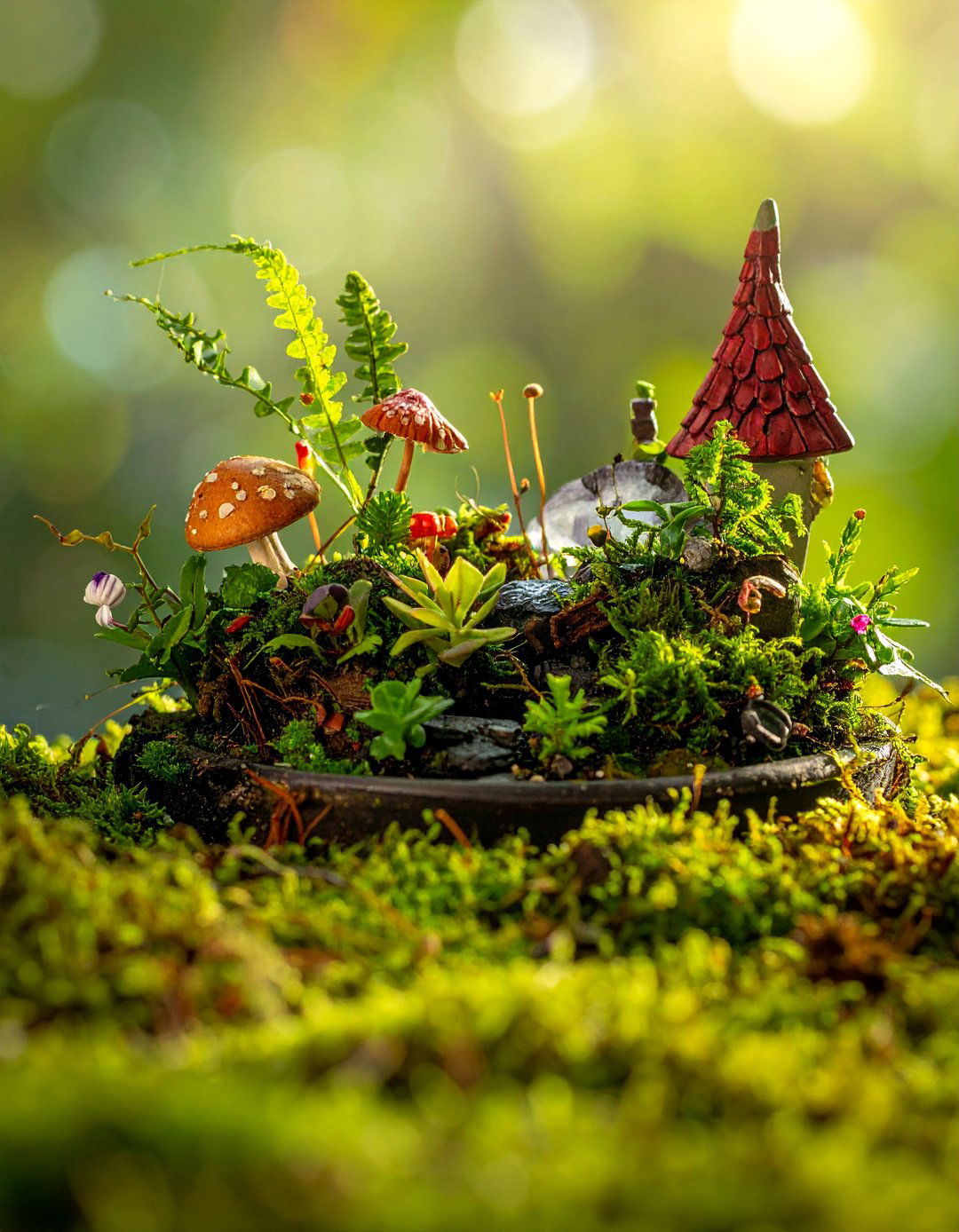
Fairy gardens create whimsical miniature landscapes that spark imagination through tiny plants, decorative accessories, and creative container arrangements. These charming displays feature small-scale plants like baby tears, miniature hostas, and dwarf conifers that maintain appropriate proportions. Decorative elements include tiny houses, furniture, pathways, and figurines that create fantasy scenes and storytelling opportunities. The design emphasizes creativity, seasonal changes, and interactive elements that engage children and adults in garden creation. These gardens work well in containers, dedicated garden areas, or integrated into larger landscape designs. Plant care focuses on maintaining scale through regular pruning and appropriate plant selection. Seasonal updates allow theme changes and creative expression throughout the year.
33. Modern Succulent Gardens
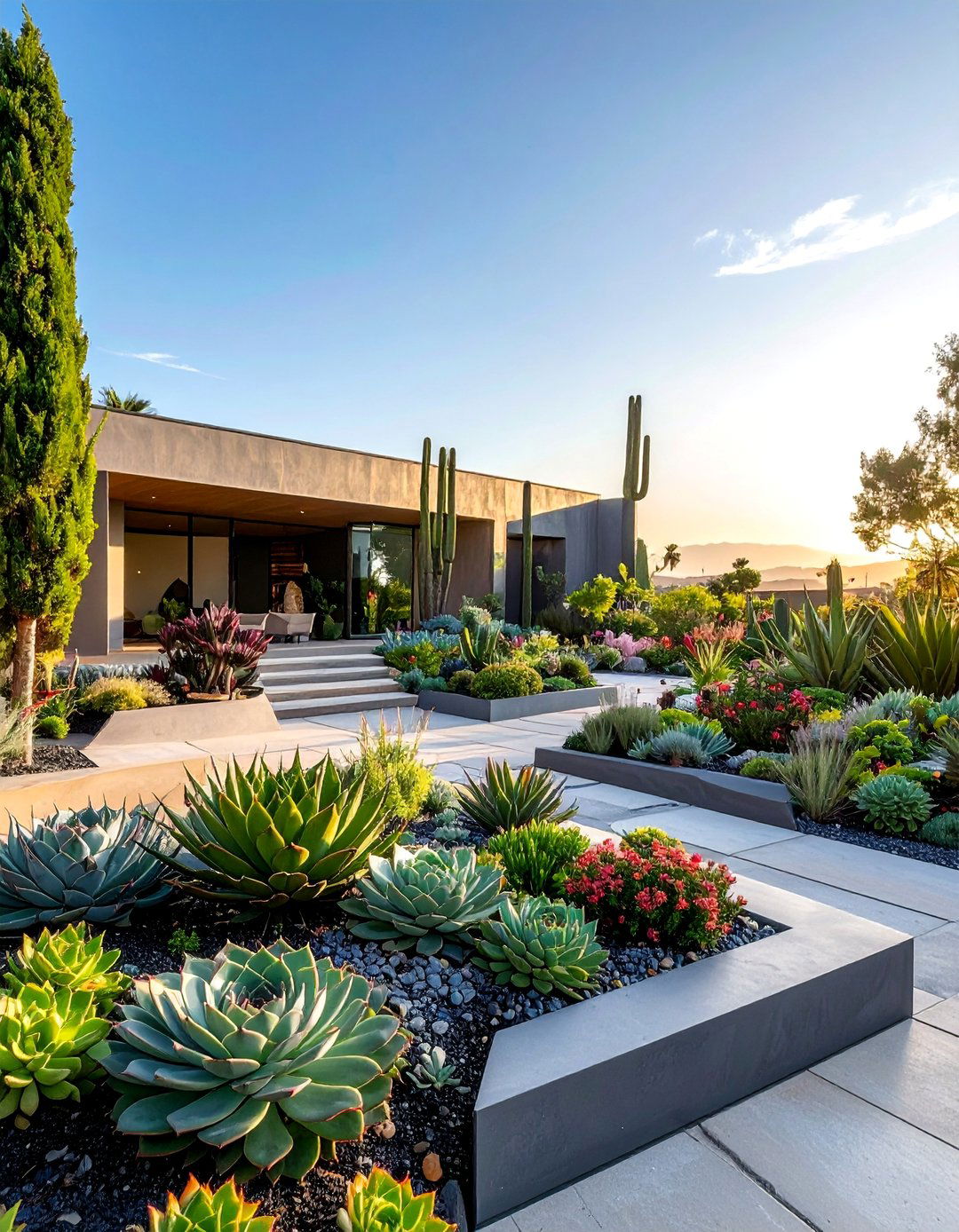
How can you create striking contemporary landscapes that require almost no maintenance yet provide year-round beauty? Modern succulent gardens showcase architectural plant forms through minimalist designs that emphasize texture, color, and geometric arrangements. These water-wise landscapes feature agaves, aloes, echeveria, and other drought-adapted species arranged in sophisticated patterns. The design incorporates clean lines, contemporary materials, and efficient irrigation systems that support sustainable gardening practices. These gardens thrive in sunny, well-drained locations while requiring minimal water and maintenance once established. Color combinations range from subtle gray-green palettes to bold arrangements featuring purple, red, and blue succulent varieties. Seasonal interest comes from flowering cycles and subtle color changes that many species display throughout the year.
34. Small Space Gardens
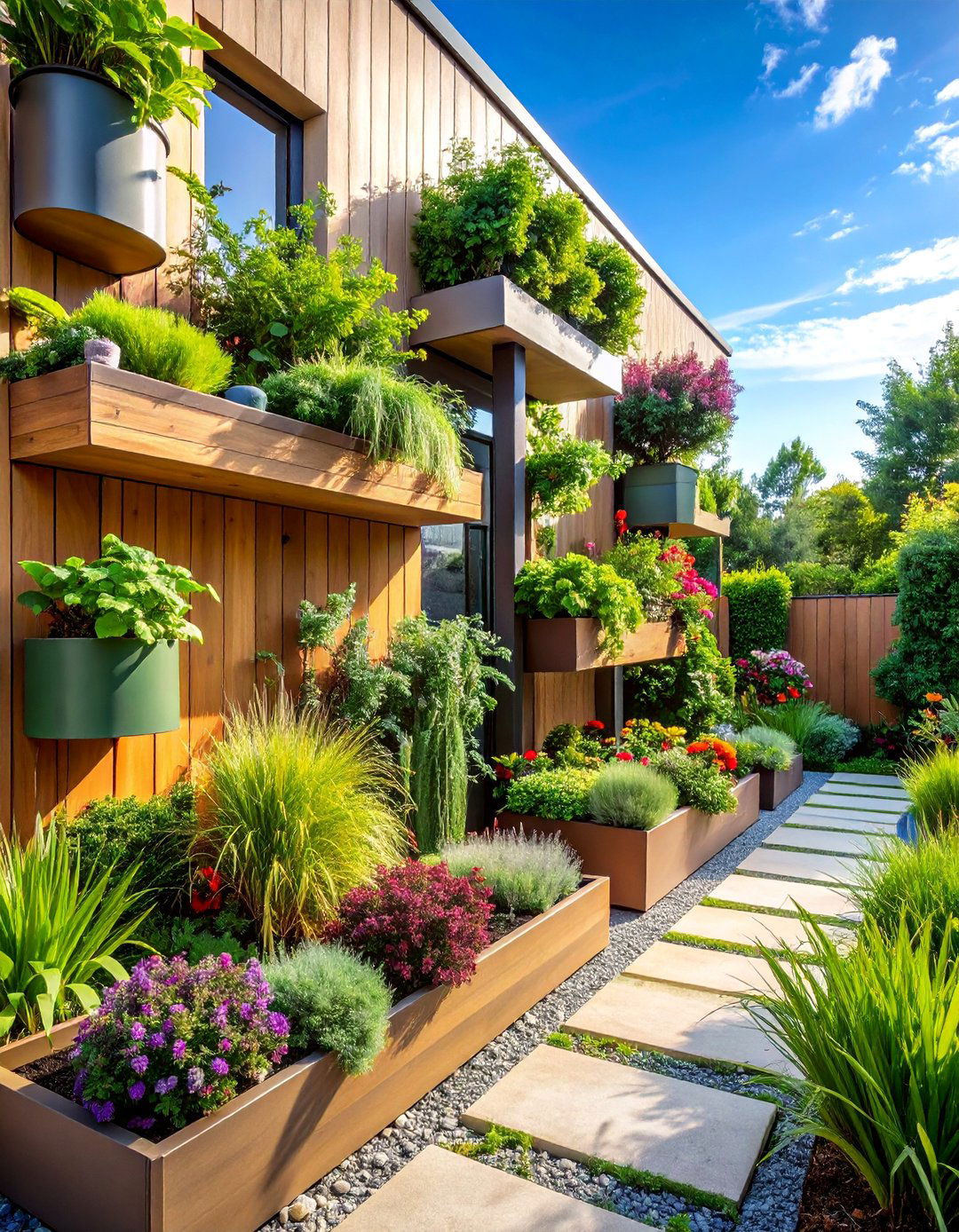
Small space gardens maximize limited areas through efficient design strategies that create functional and beautiful outdoor environments. These creative solutions use vertical growing, multi-purpose plants, and space-saving techniques that accommodate diverse gardening goals in minimal areas. Container systems, wall-mounted planters, and tiered arrangements multiply growing space while maintaining accessibility for maintenance and harvest. Plant selections emphasize compact varieties, seasonal interest, and species that provide maximum impact in limited space. The design principles include strategic color use, clever storage solutions, and multi-functional elements that serve both practical and aesthetic purposes. These gardens demonstrate that size limitations need not restrict gardening enjoyment or productivity. Regular maintenance keeps plants healthy while maximizing visual appeal.
35. Winter Interest Gardens
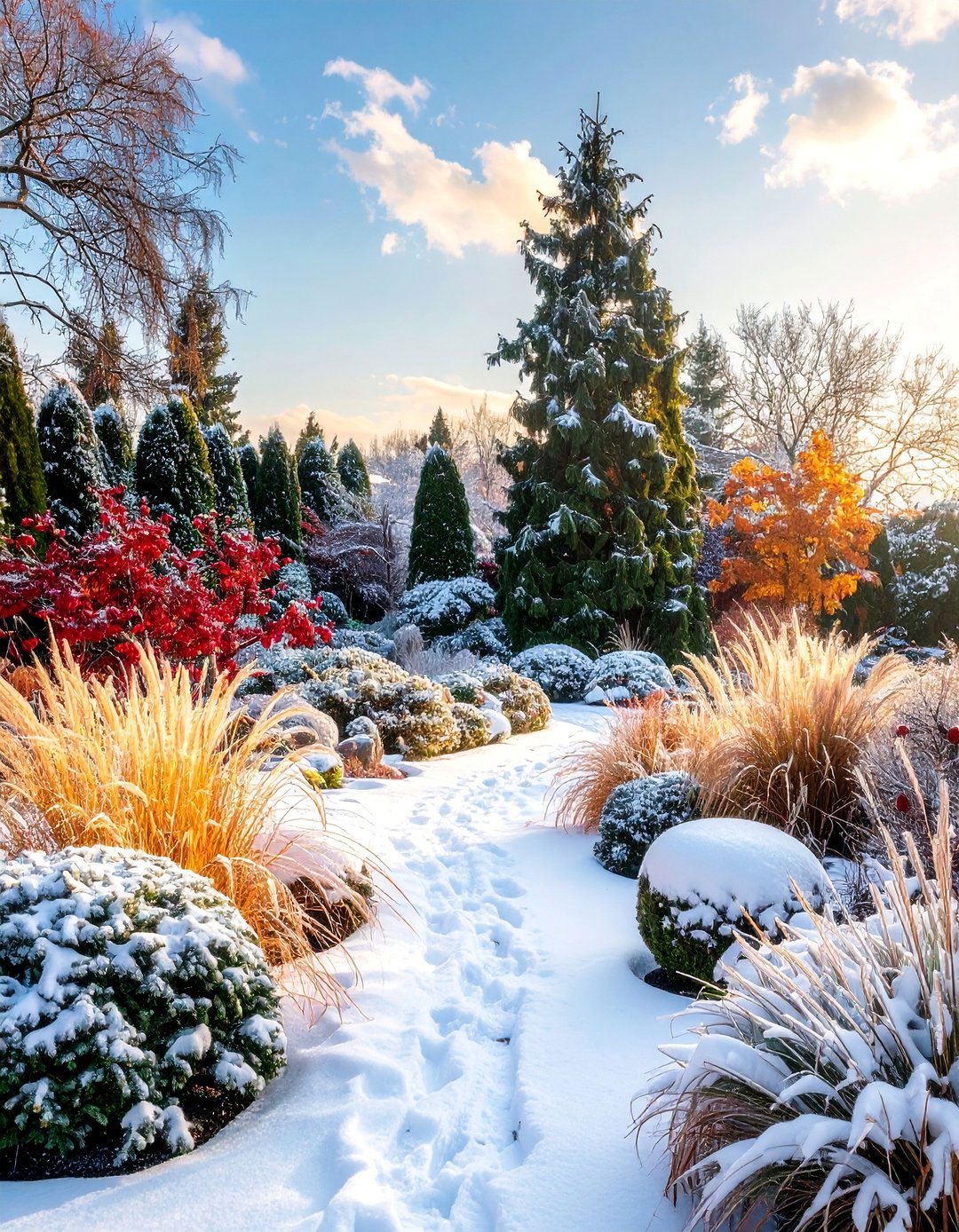
Winter interest gardens provide beauty during dormant seasons through plants selected for their bark, berries, evergreen foliage, and architectural structure. These year-round landscapes feature ornamental grasses, colorful-stemmed shrubs, and plants with persistent fruit that attract wildlife during cold months. The design emphasizes texture, form, and color that remain attractive when most plants are dormant. Evergreen plants provide structure while deciduous species offer seasonal changes and winter silhouettes. These gardens support wildlife during challenging seasons while maintaining landscape appeal throughout the year. Plant selections consider regional climate conditions and species that perform reliably in local winter weather. Maintenance includes minimal pruning and cleanup that preserves winter features while preparing for spring growth.
36. Therapeutic Healing Gardens
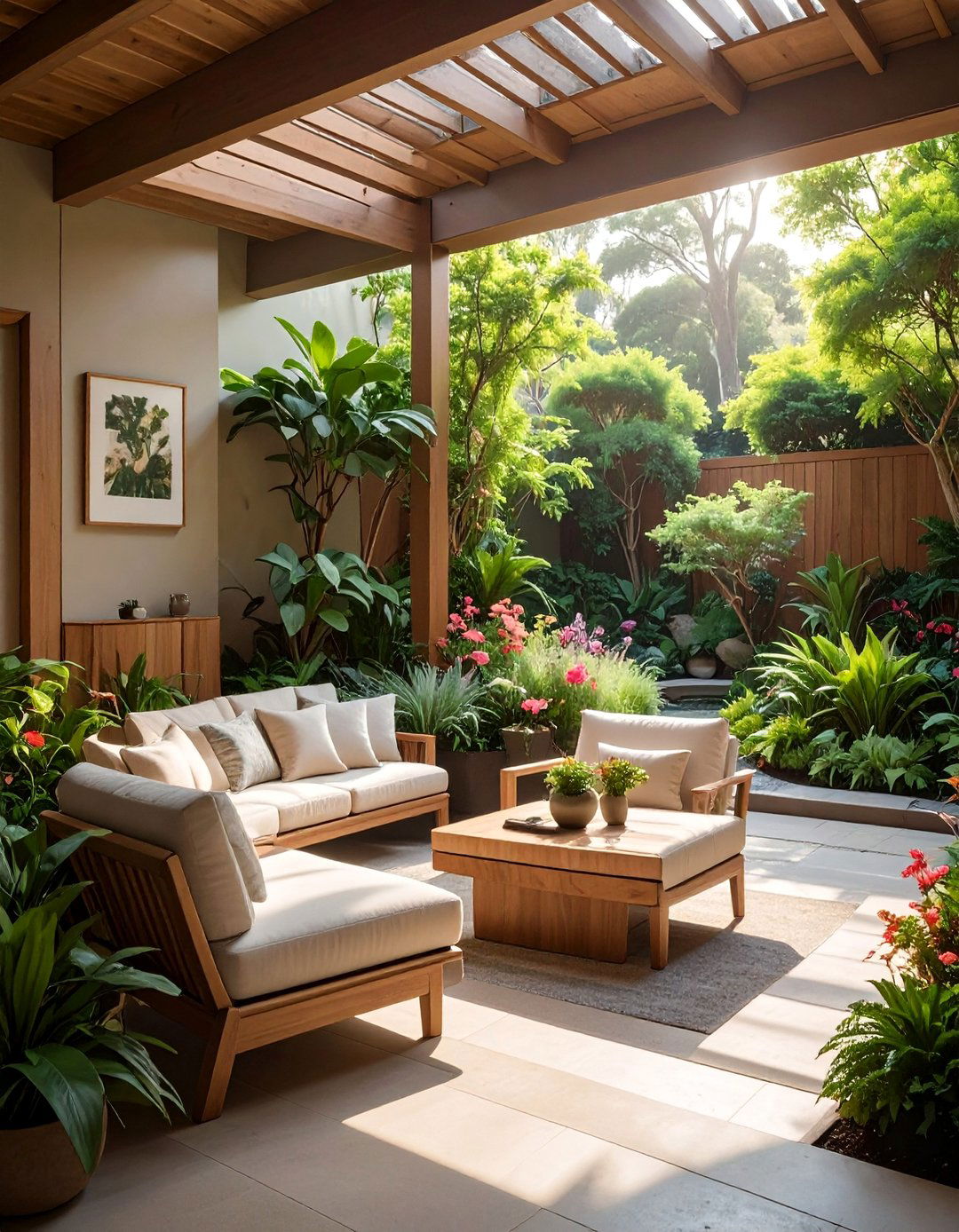
Therapeutic gardens promote physical and emotional well-being through thoughtfully designed spaces that encourage relaxation, meditation, and gentle physical activity. These restorative environments feature comfortable seating, accessible pathways, and plants chosen for their calming effects and sensory qualities. The design emphasizes natural materials, gentle water features, and peaceful arrangements that reduce stress while promoting healing. Plant selections include fragrant herbs, soft textures, and species that provide visual interest without overwhelming busy minds. These gardens serve particular populations including hospitals, senior communities, and wellness centers where outdoor access supports recovery and quality of life. Maintenance focuses on keeping spaces safe, accessible, and visually appealing while preserving the intended therapeutic qualities.
37. Hummingbird Gardens
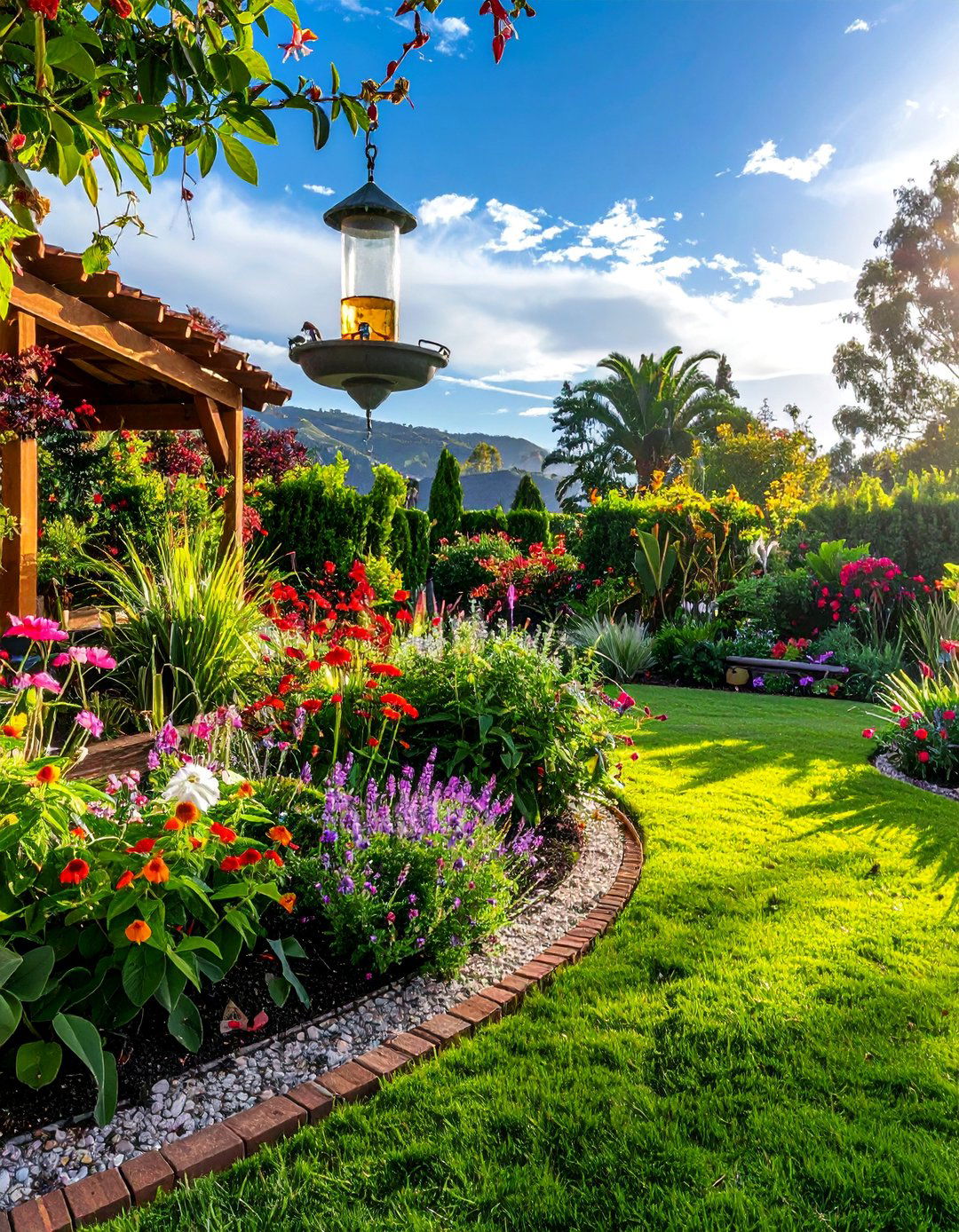
Are you fascinated by these tiny, jewel-like birds and want to attract them to your outdoor space? Hummingbird gardens create specialized habitat through plants that provide nectar sources, nesting materials, and territorial perches that support hummingbird populations. These dynamic spaces feature tubular flowers like bee balm, cardinal flower, and trumpet vine that accommodate hummingbird feeding behaviors. The design includes sugar water feeders, shallow water sources, and small trees or shrubs that provide nesting sites. Native plant selections offer authentic food sources while supporting the complete ecosystem that hummingbirds depend upon. These gardens provide entertainment and educational opportunities while supporting declining pollinator populations. Maintenance includes regular feeder cleaning, seasonal plant care, and avoiding pesticide use that could harm these sensitive birds.
38. Drought-Resistant Gardens
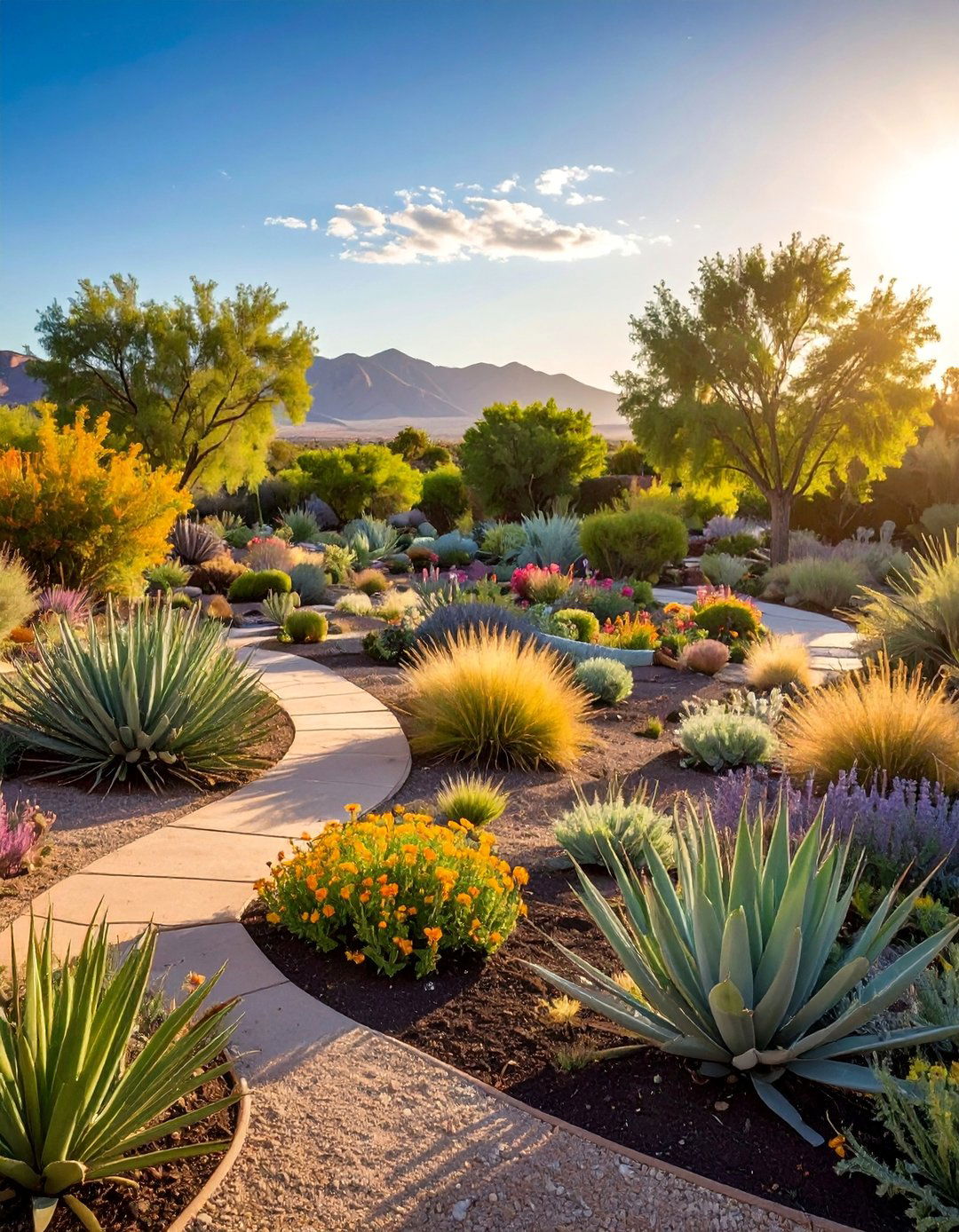
Drought-resistant gardens address water scarcity through beautiful plantings that thrive with minimal irrigation while providing maximum visual impact. These sustainable landscapes feature native plants, efficient irrigation systems, and design strategies that conserve water while maintaining attractive outdoor spaces. Plant selections emphasize species adapted to local rainfall patterns and soil conditions that require minimal supplemental watering. The design incorporates mulching, proper soil preparation, and strategic plant placement that maximizes water efficiency. These gardens reduce maintenance requirements while supporting environmental stewardship goals in water-limited regions. Seasonal interest comes from drought-adapted flowering plants, ornamental grasses, and architectural species that provide year-round structure. Maintenance focuses on efficient watering practices and plant care that maintains garden health during dry periods.
39. Perennial Border Gardens
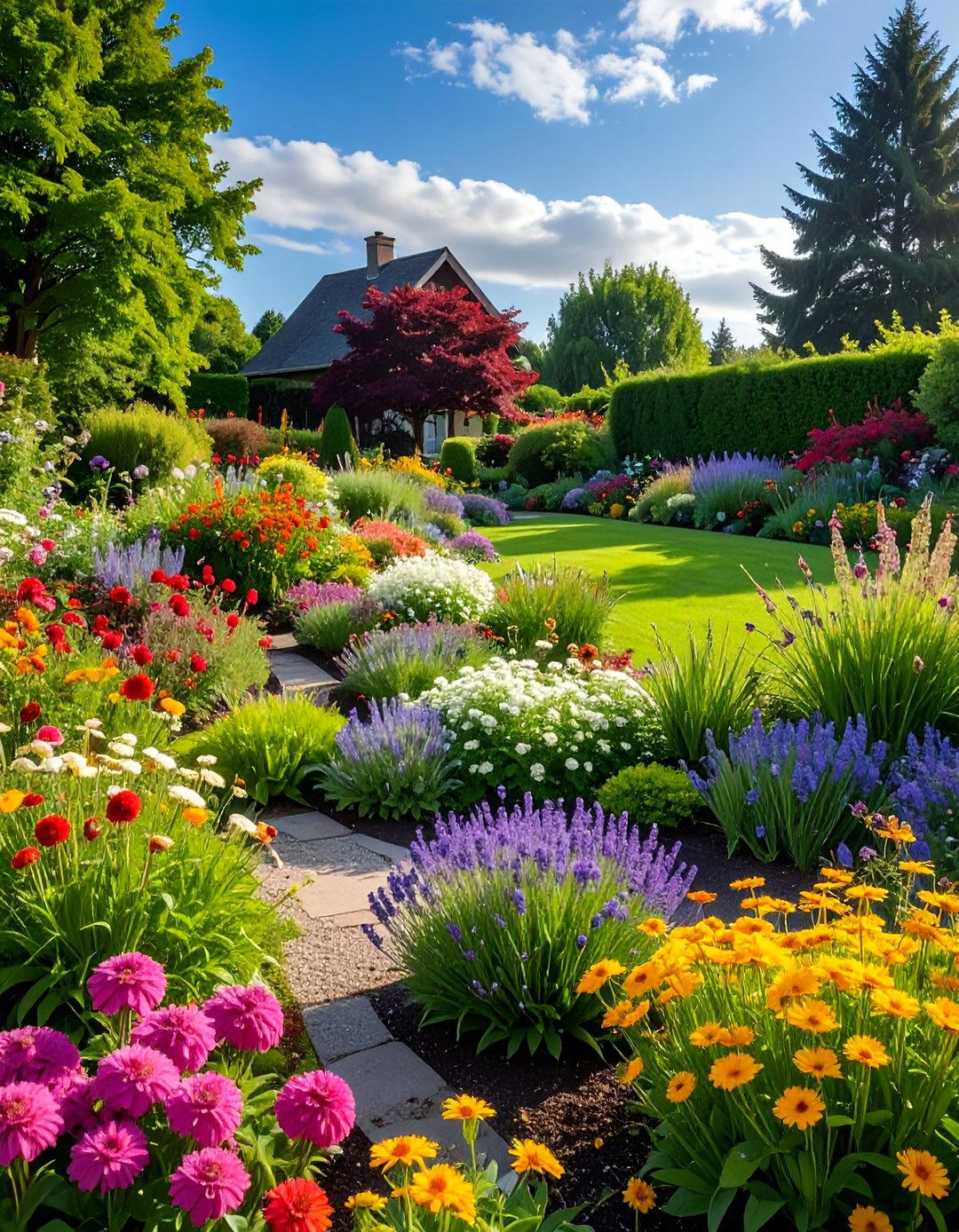
Perennial border gardens create spectacular seasonal displays through carefully planned plantings that return year after year with increasing beauty and size. These classic landscapes feature herbaceous plants arranged by height, bloom time, and color combinations that provide continuous interest throughout growing seasons. The design principles include layered planting schemes, complementary color palettes, and structural elements that support tall plants and maintain visual appeal. Plant selections emphasize reliable performers, diverse bloom times, and species that provide multi-season interest through foliage, flowers, and seed heads. These gardens mature over several years as plants establish and fill their designated spaces. Maintenance includes seasonal cleanup, periodic division, and soil improvement that maintains plant health and flowering performance throughout the garden's development.
40. Zen Meditation Gardens
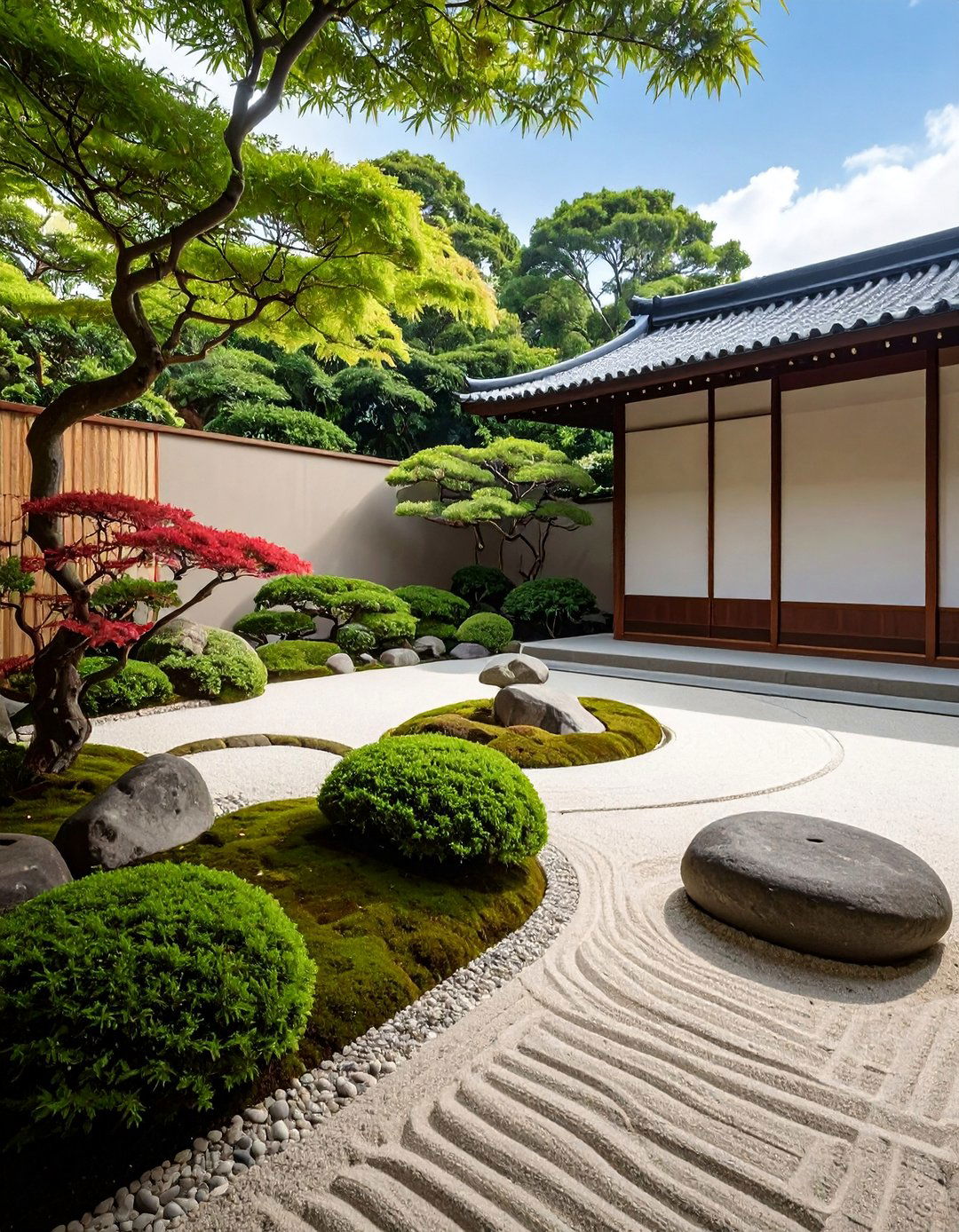
Zen meditation gardens create peaceful retreats through minimalist design principles that emphasize simplicity, balance, and natural harmony. These contemplative spaces feature carefully arranged elements including water, stone, plants, and open areas that encourage reflection and mindfulness. The design follows Japanese aesthetic principles that create tranquil environments conducive to meditation and stress reduction. Plant selections emphasize evergreen species, simple forms, and subtle seasonal changes that maintain peaceful atmospheres throughout the year. These gardens provide escape from busy lifestyles while offering opportunities for quiet contemplation and spiritual renewal. Maintenance involves preserving the intended simplicity through careful pruning, raking, and attention to detail that maintains the garden's meditative qualities. The result creates authentic sanctuaries that support mental and emotional well-being through connection with nature.
Conclusion:
Creating a beautiful garden is one of life's most rewarding experiences, offering endless opportunities to express creativity while connecting with nature. Whether you choose a romantic cottage garden overflowing with fragrant blooms, a sleek modern design with architectural plants, or a sustainable native landscape that supports local wildlife, the perfect garden style awaits your personal touch. Today's gardening trends emphasize sustainability, low-maintenance approaches, and designs that serve multiple purposes from food production to wildlife habitat. Small spaces need not limit your gardening dreams, as vertical gardens, container systems, and creative design solutions can transform even the tiniest balcony into a green oasis. The key lies in choosing plants and design elements that suit your climate, lifestyle, and personal preferences while creating outdoor spaces that bring joy throughout all seasons of the year.

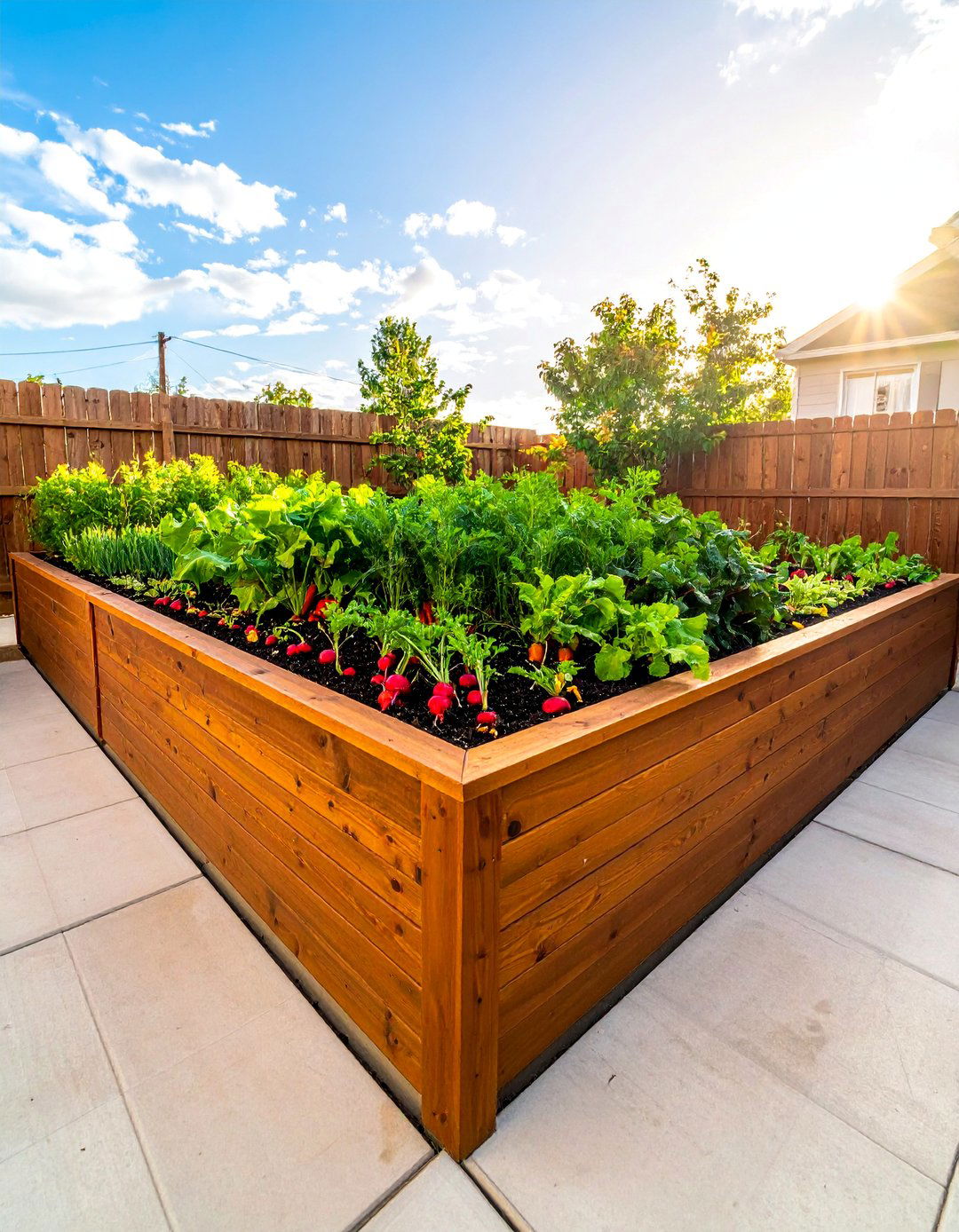
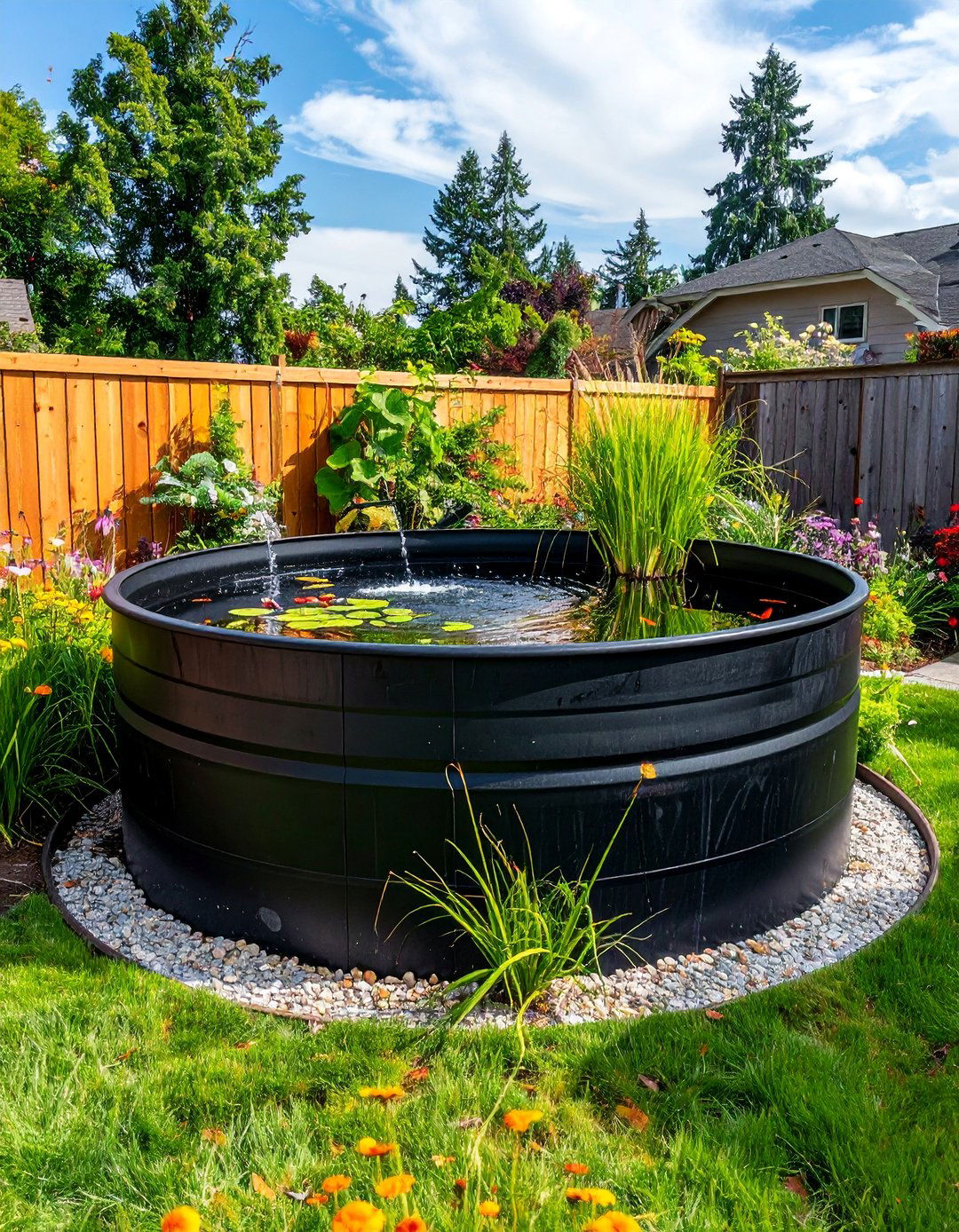
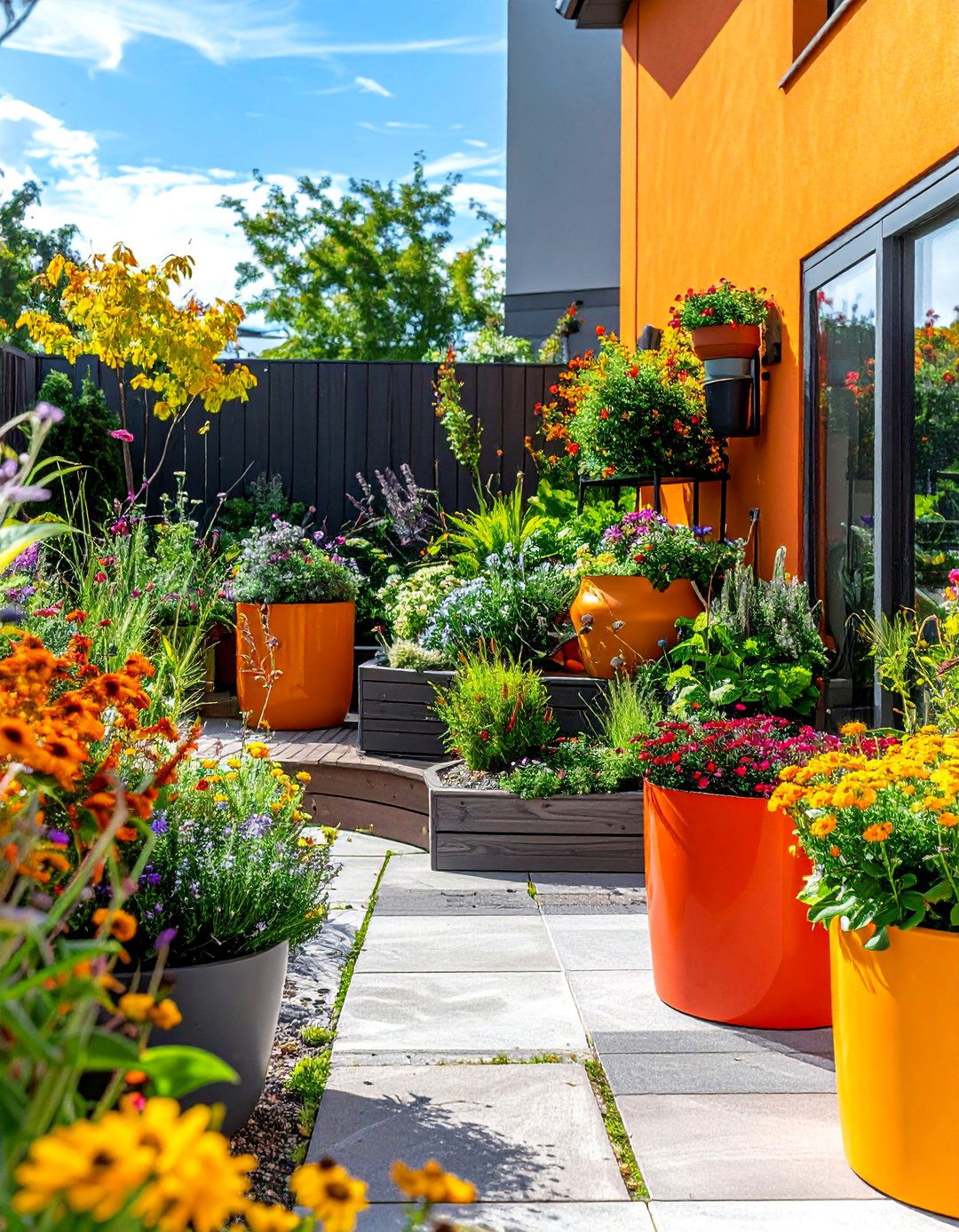
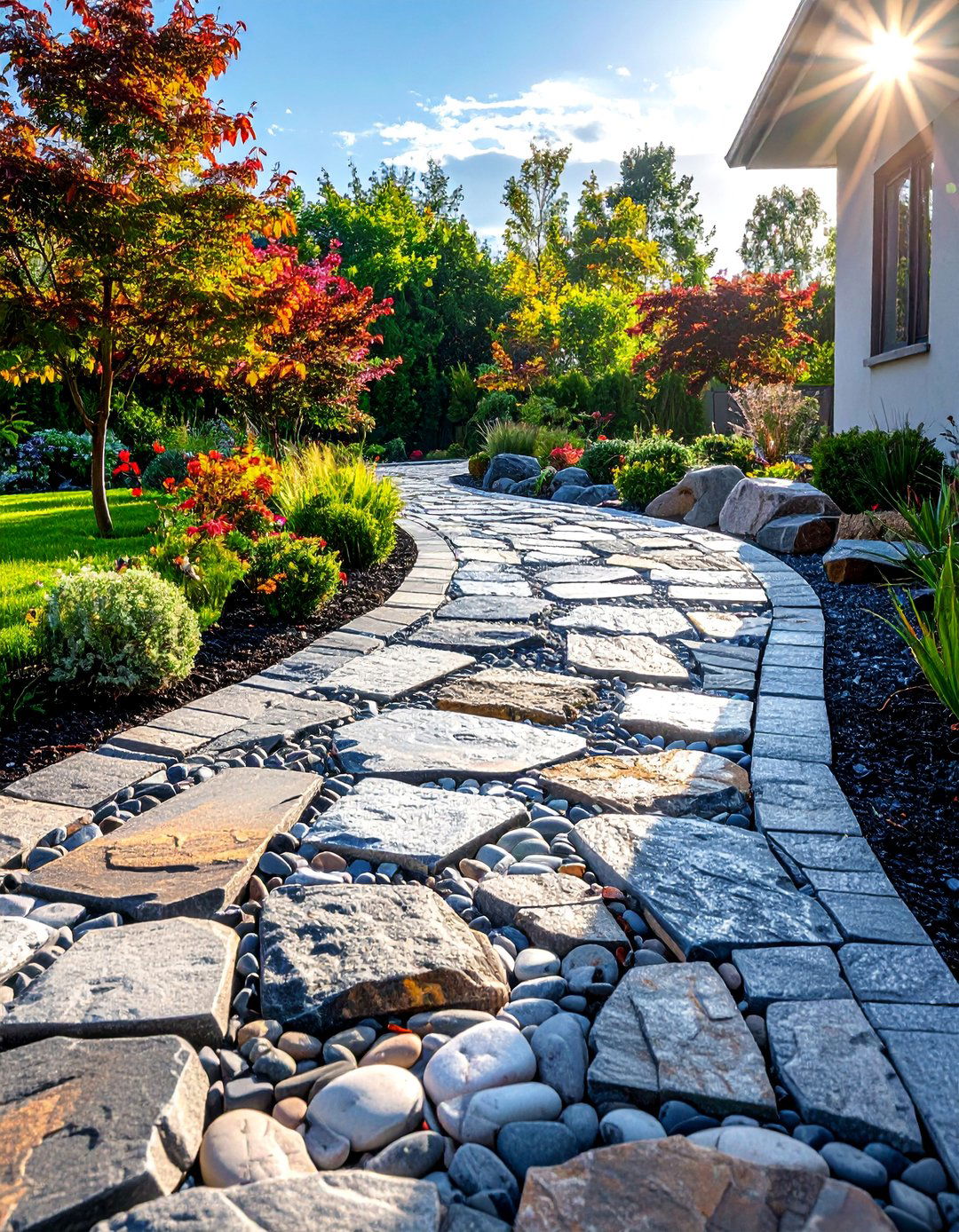
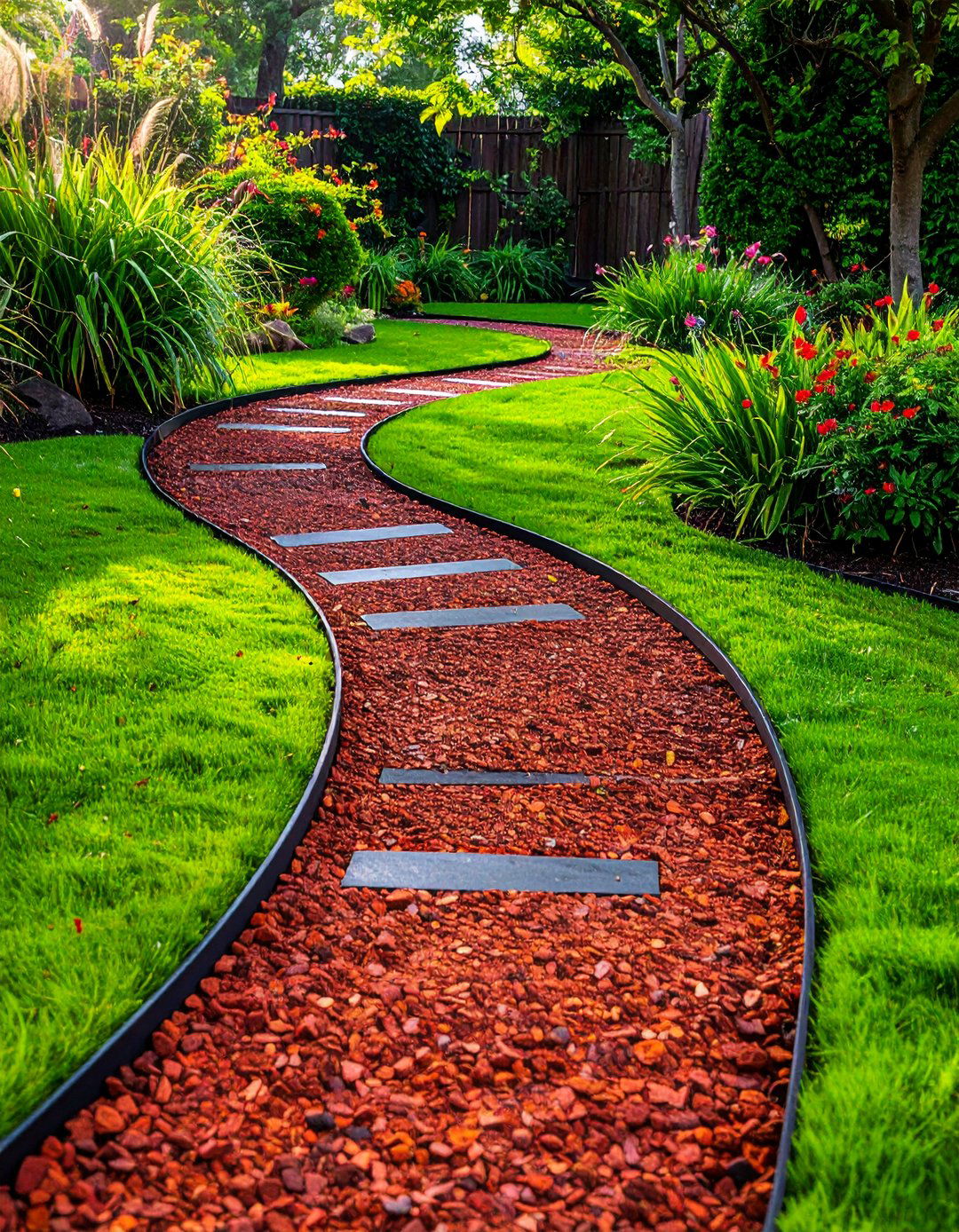
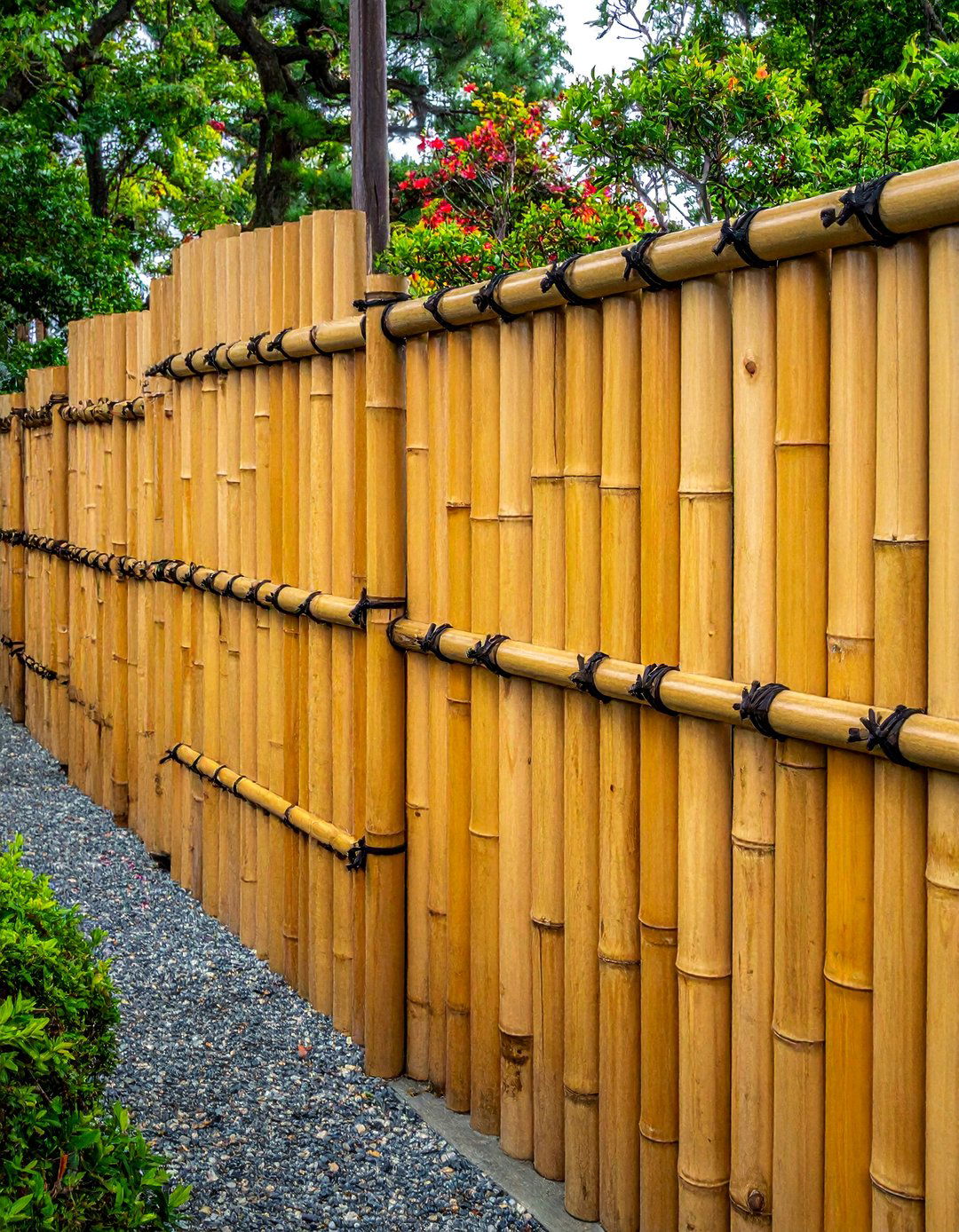
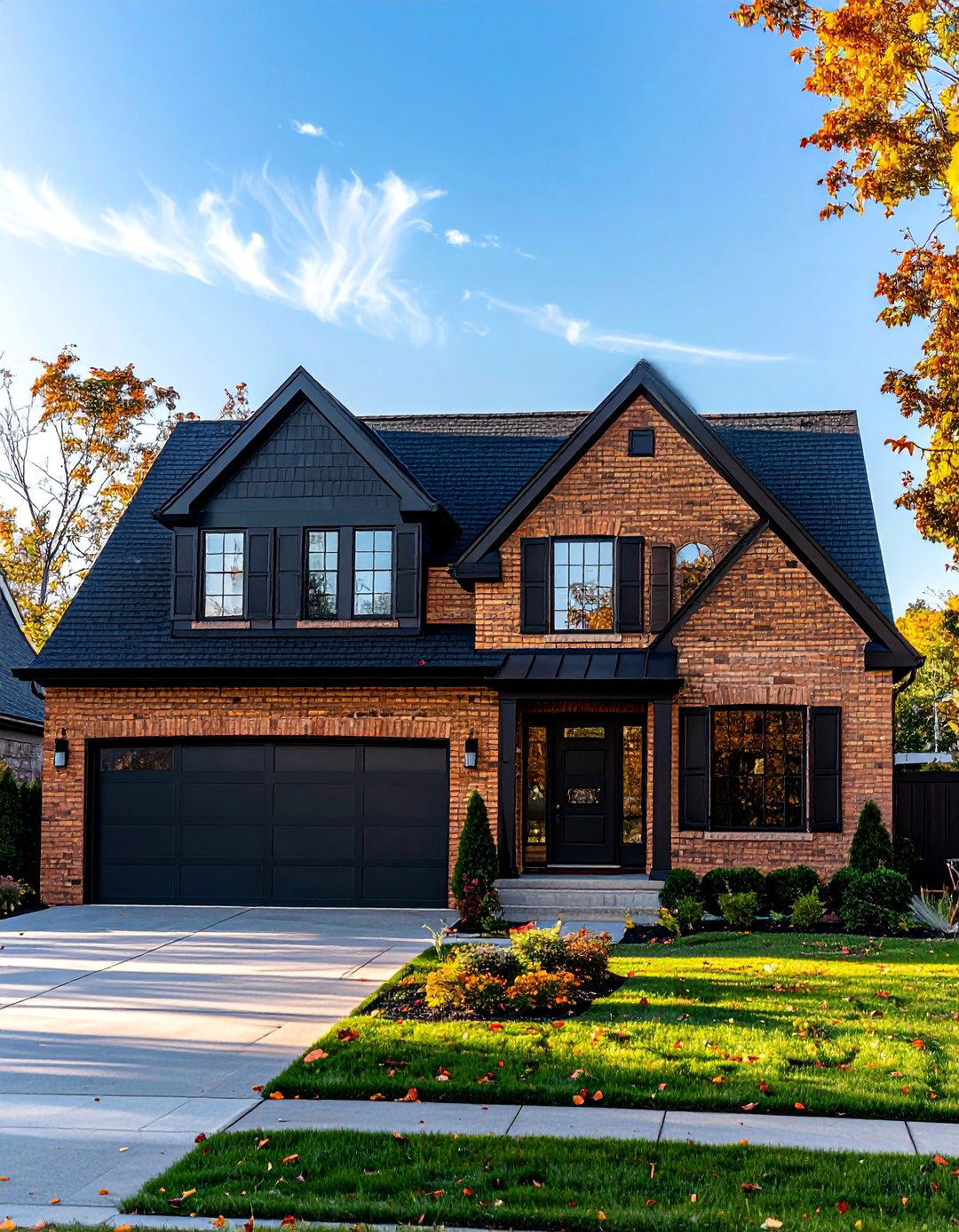
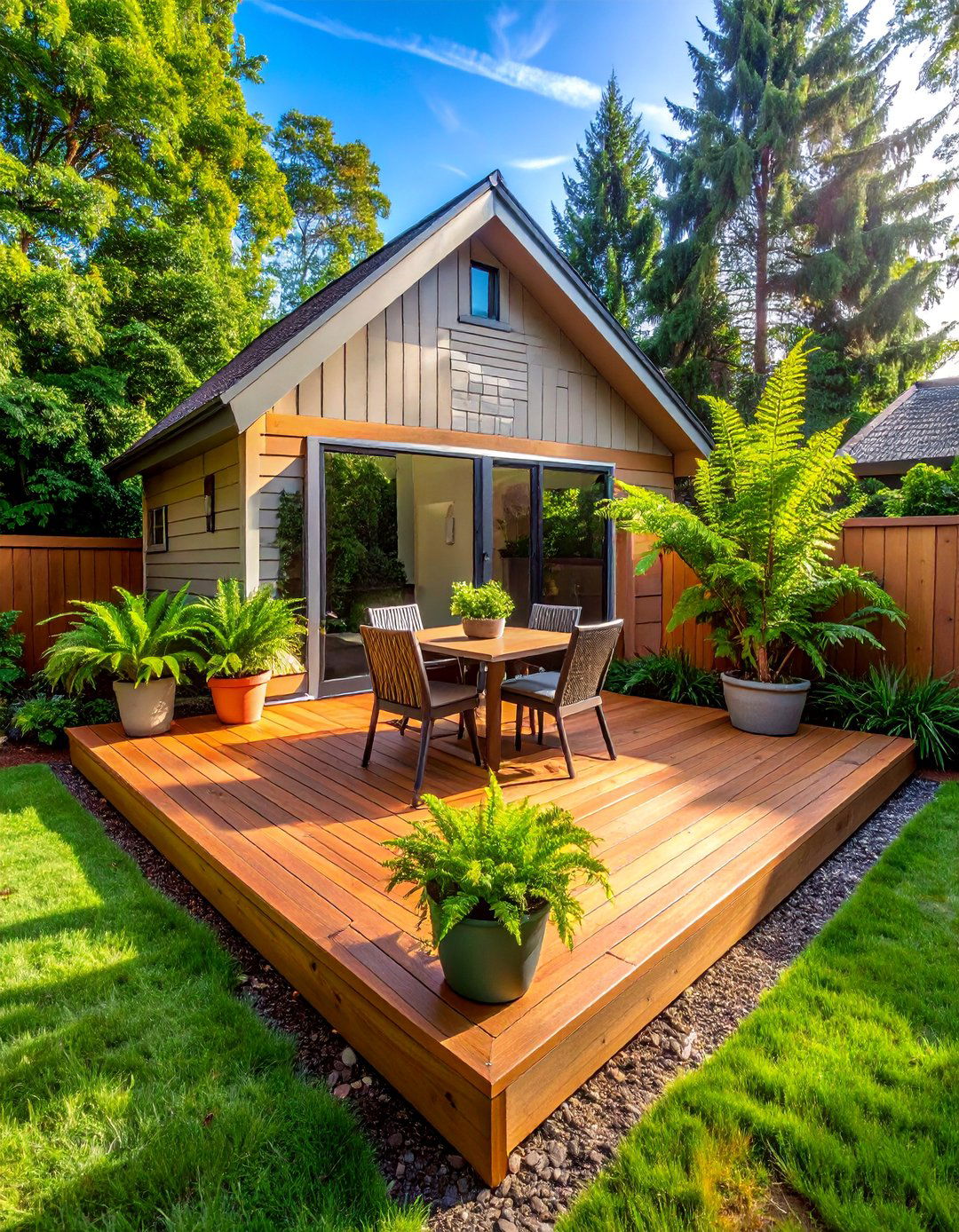
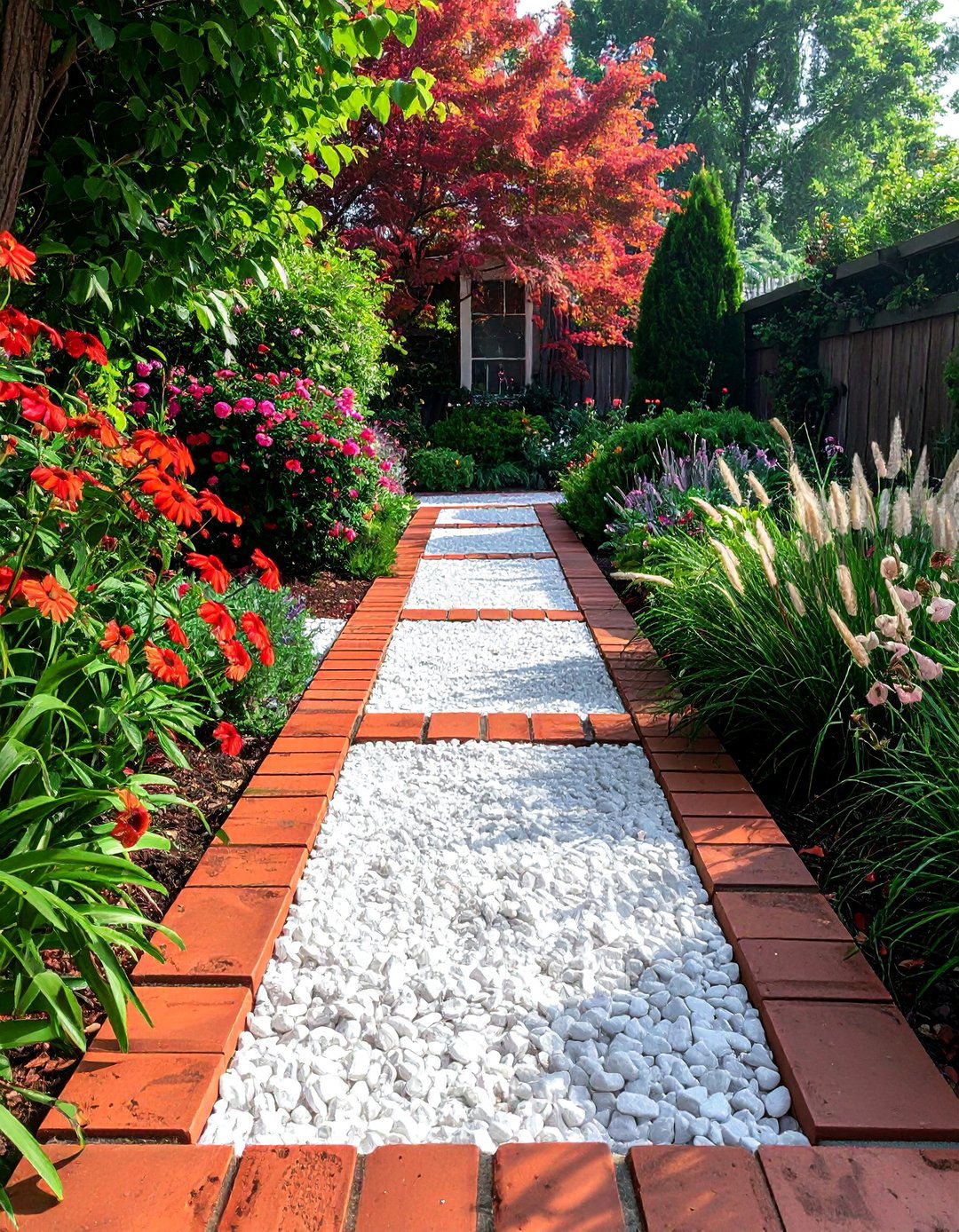
Leave a Reply